Star Trek vs. Star Wars

Star Trek , originally a TV series, is a space western science fiction that centers around a crew who serves in Starfleet , a space-based peacekeeping and humanitarian armada. Star Wars , originally a trilogy, is a space opera fantasy franchise set in the distant past of a fictional galaxy, revolving around princes, princesses, knighthood, and chivalry. Both these highly popular and successful franchises are now being revived with new movies directed by J.J. Abrams.
Until the recent movies, Star Trek has been more of a cult phenomena than Star Wars , and therefore did not have the same level of mainstream fandom and cultural influence. Star Wars is grander in scope and has a complex web of political agendas, alien species, personal feuds, and galaxy-wide domination. The Star Trek world is modern, sleek, and shiny, while some of Star Wars' settings are dirty and grimy.

Comparison chart
Originally a television series, Star Trek has generally used the same basic plot setup: an altruistic crew is placed in situations of moral dilemma, which are often allegorical nods to current social and political issues. Issues covered include imperialism, war and peace, racism, class warfare, feminism, and human rights. The core characters, Captain Kirk , Spock, Scotty, Uhura, and Pavel Chekov, comprise humans and humanoid alien species. Star Trek only gained mainstream fame after the release of its films in 2009 and 2013. The video below briefly touches on the history of Star Trek :
Star Wars uses archetypes of the fantasy genre, such as princesses, knighthood, and chivalry, and action unfolds in a contest between good and evil. The Star Wars universe is laden with political science elements and historical inspiration. The plot climax of the Rebel Alliance fights for freedom from the Galactic Empire was drawn from the fall of the Roman Republic and the formation of an empire. This 10 minute video gives a retrospective look into the original trilogy of Star Wars :
Science and Fantasy
Common belief is that Star Trek is science fiction, while Star Wars is science fantasy. The technology in Star Trek is supposed to be at least loosely grounded in science or potential future science , rather than supernatural forces or magic. The most visible technologies include personal communication and triangulation devices (inspirations for modern day smart phones), warp drive travel for space ships, and teleporting ( “Beam me up, Scotty” ). The chief technologist for Google Earth has said that the tricorder’s mapping capability was one inspiration for Google Earth.
Star Wars , on the other hand, is not focused on the real-world viability of its science, as it is more science fantasy than science fiction. One of the core elements of its stories is the existence of the “Force”, an omnipresent energy that surrounds all living things and that can be harnessed by those with special abilities. The Force allows for acts of telekinesis, mind control, clairvoyance, and precognition, and can also make a person more physically capable.
Production History
After two Star Trek pilots were made, the original series aired for three years in the late sixties. Despite a fervent fan base, ratings were disappointing, and the show was canceled. Except for an animated series in the mid 70s, no new Star Trek productions were released until the first feature film in 1980. This revived the franchise , and 11 more movies followed, along with overlapping television series running until 2005. The Star Trek reboot films in 2009 and 2013 directed by J.J. Abrams brought a new style to the franchise, and functioned as broad-appeal blockbusters, rather than just being events for long-standing fans of the show.
Unlike Star Trek , Star Wars began as a motion picture rather than a television series. Universal Studios first agreed to make George Lucas’s Star Wars in 1971, but it took several years and multiple script revisions for the project to begin. The original film was finally released in 1977 to worldwide fanfare and became a pop culture phenomenon. Two sequels were released at three year intervals. 16 years after the third film, the first film in a new prequel trilogy was released. A third trilogy has recently been announced: Star Wars Episode VII will be released in 2015, and is being directed by J.J. Abrams, the same director who was in charge of the Star Trek reboot.
Political and Social Elements
When Roddenberry conceived the original show, he did so with a highly progressive, liberal agenda in mind, reflecting the counter culture movement sweeping the nation in the 1960s, although he was not totally forthcoming with the television networks about this element of the show. Star Trek was Roddenberry’s vision of what society could become in the future if humanity learned from its past mistakes. It was one of the first shows to have a mixed race cast.
Star Wars is a classic epic of good versus evil. The Jedi use the Force for good, while the Sith use the Force for evil. Star Wars functions less as commentary on specific social issues, but operates on the grander operatic struggle of dark vs light, dictatorships versus democracies, etc. However, many have attempted to draw parallels between Star Wars and the reality of history and politics , as seen in this video :
Pop Culture and Legacy
Star Trek has a devoted cult following of hardcore fans known as “Trekkies”. There are various Trekkie conventions all over the world where fans dress up in costumes and may have a chance to meet cast members, or to discuss the issues of the show. Some Trekkies even learn the show’s constructed language , Klingon. There was a Star Trek -themed attraction in Las Vegas for 10 years. Two museum exhibits of props travel the world. A NASA space shuttle was named after the crew’s ship , the Enterprise.
The Star Wars movies have expanded into a massive web of spinoffs and products, including books, video games , made-for-TV movies, comic books, animated series, theme park attractions. Even several animal species have been named after Star Wars characters. References to Star Wars are common in movies and the media.
Famous Quotes
- "KHAAANNNN!" -Captain Kirk
- "It can be argued that a human is ultimately the sum of his experiences." --Benjamin Sisko
- "I would be delighted to offer any advice I can on understanding women. When I have some, I'll let you know." -Captain Picard
- "Excuse me… Excuse me. I’d just like to ask a question… What does God need with a starship?" -Captain Kirk
- "What we leave behind is as important as how we’ve lived. After all, Number One, we’re only mortal." -Picard "Speak for yourself, sir. I plan to live forever. -Riker
- The truth is usually just an excuse for a lack of imagination. -Garak
- "May the Force be with you."
- “Do. Or do not. There is no try.” -Yoda
- “Help me Obi-Wan Kenobi. You’re my only hope.” -Luke Skywalker
- “You don’t need to see his identification … These aren’t the droids you’re looking for … He can go about his business … Move along.” - Obi-Wan Kenobi
- “Use the Force, Luke.” - Obi-Wan Kenobi
- “I find your lack of faith disturbing.” -Darth Vader
- “Fear is the path to the dark side…fear leads to anger…anger leads to hate…hate leads to suffering.” -Yoda
- “When I left you, I was but the learner, now I am the master.” -Darth Vader “Only a master of evil, Darth.” -Obi-Wan Kenobi
- “I’ve got a very bad feeling about this.” - Han Solo
- “Wars not make one great.” -Yoda
- “A Jedi uses the Force for knowledge and defense, never for attack.” -Yoda
Star Trek Stills
Star wars stills.
- Wikipedia: Star Wars
- Wikipedia: Star Trek
- Wikipedia: Comparison of Star Trek and Star Wars
- The Official Star Wars Blog
- The Official Star Trek Website
- The 10 Best Yoda Quotes - Star Wars Blog
- Top 10 Star Trek Quotes - Science Channel
- Star Trek Trivia - IMDB
- Star Wars: Episode IV Trivia - IMDB
Related Comparisons

Share this comparison via:
If you read this far, you should follow us:
"Star Trek vs Star Wars." Diffen.com. Diffen LLC, n.d. Web. 2 May 2024. < >
Comments: Star Trek vs Star Wars
- Captain Kirk vs Captain Picard
- Bruce Lee vs Chuck Norris
- Batman vs Superman
- Disneyland vs Disney World
- American Dad! vs Family Guy
- Harry Potter vs Lord Of The Rings
- Batman vs Robin
- Batman vs Spiderman
Edit or create new comparisons in your area of expertise.
Stay connected
© All rights reserved.
- Stranger Things Season 5
- Deadpool and Wolverine
- The Batman 2
- Spider-Man 4
- Yellowstone Season 6
- Fallout Season 2
- The Last of Us Season 2
- Entertainment
Star Trek vs. Star Wars: which one is better in 2023?
For as long as both entities have existed, fans of science fiction and fantasy have debated the merits of Star Trek and Star Wars . But for most of the 45 years that the two franchises have overlapped, Star Trek and Star Wars haven’t actually had much in common, apart from their cosmic setting. Star Trek is an aspirational sci-fi series set in humanity’s future, while Star Wars is a bombastic fantasy adventure that takes place in a far-off galaxy. One has primarily lived on weekly television, while the other has broken big-screen box office numbers.
Star Trek and Star Wars have both leaned heavily into fan service
The streaming era has let both franchises experiment.
- The streaming bubble is forcing Star Trek and Star Wars to pump the brakes — and that’s good
However, in recent years, both Star Trek and Star Wars have become tentpoles for their parent companies’ subscription streaming services , Paramount+ and Disney+ , respectively, each pumping out a steady stream of content in an ever-widening array of formats. This has led them to encroach further into each other’s territory than ever before. Star Trek vs. Star Wars is no longer an apples-to-oranges comparison — they are directly competing products, sharing some of the same ambitions and struggling against the same environmental forces.
We will likely never settle on which space franchise is the greatest of all time, but we can take a moment to ask: Which is better right now?
- Disney+ reveals the first trailer for Star Wars: Tales of the Empire
- Star Wars could’ve had Christopher Walken as Han Solo and Jodie Foster as Princess Leia
- Did Andor ruin Ahsoka, and maybe the entire Star Wars franchise, by being too good?
Studios have become increasingly risk-averse during the streaming era, and that’s meant relying on recognizable brands with loyal fanbases who will remain subscribed to a service as long as there are new releases within their favorite fictional universe. However, this dependence has also left streamers at the mercy of those same fans, who can now use social media to converse with creators or even make demands. While this can lead to crowd-pleasing moments like the return of popular characters or the inclusion of fan-promoted memes back into the product, it can also create a feedback loop in which creators continue to serve audiences slight variations on whatever fans say they like rather than expanding their worlds or telling new stories.
Over the past two years, both Star Trek and Star Wars have released series that are representative of this shamelessly fan-oriented approach. In 2022, Paramount+ released the first season of Star Trek: Strange New Worlds , a prequel series set aboard the original USS Enterprise and starring Anson Mount as Captain Kirk’s predecessor Captain Christopher Pike. This series was prompted by a vocal fan campaign after legacy characters Pike, Mr. Spock, and Number One were featured in the second season of Star Trek: Discovery in 2019. A petition to give these characters their own spin-off received over 30,000 signatures, eventually leading to Strange New Worlds receiving a series order. Happily, the fans were right about this one, and Strange New Worlds has become more than just a nostalgic throwback to classic Trek , but exactly the shot in the arm the franchise needed. The series retains the episodic format of pre-streaming Trek series, but benefits from modern production values, a charming cast, and a sense of joy and wonder that the serialized Trek shows Discovery and Picard have yet to deliver.
The recent third season of Star Trek: Picard has also been a serious crowd-pleaser, reuniting the cast of Star Trek: The Next Generation for one last 10-hour adventure. Though certainly the most recursive and least imaginative new installment of Trek’s streaming era, it has been wildly popular among fans, well-received by critics, and is the first Trek series to make a dent into Nielsen’s weekly Top 10 streaming charts. A petition to launch a sequel series featuring Picard ’s younger cast members has surpassed the one that demanded a spin-off for Pike’s Enterprise, with over 44,000 signatures to date. There is a vocal online contingent that wants to hand the keys to the franchise to this season’s showrunner, gushing Star Trek fanatic Terry Matalas.
The current state of the Star Wars Galaxy should be a warning against that particular future for Star Trek . While ascended fan and George Lucas apprentice Dave Filoni has produced some of the best Star Wars television, such as the animated Star Wars Rebels and the incredible final season of The Clone Wars , his insistence upon building every new series directly on the back of the last one has left the Star Wars galaxy feeling both smaller and more confusing than it has in decades. Characters’ stories weave between animated and live-action series, making each product harder to follow on its own. Important character beats for the main characters of The Mandalorian are resolved in The Book of Boba Fett . Ahsoka is a live-action spin-off for the popular Clone Wars character, but is also a sequel to Rebels , seeded in a number of Mandalorian episodes . Die-hard fans will have no trouble following this and delight in getting to see their favorite animated characters brought to life in live-action follow-ups, but this comes at the expense of what has always been Star Wars ’ greatest advantage over Star Trek : accessibility.
Meanwhile, the desire to tickle fans’ nostalgia glands with returning characters from the franchise’s past has resulted in creative misfires like the most recent Star Wars feature film, The Rise of Skywalker , the underwhelming Obi-Wan Kenobi streaming series, and the ghoulish practice of digitally applying the faces of young Mark Hamill or the late Carrie Fisher onto new actors. These are indications that even the unstoppable forces of time and death will not dissuade Disney from recycling the most popular Star Wars elements ad infinitum. That way lies madness.
Point: Star Trek
Prior to the streaming wars, Star Trek and Star Wars each had their own clearly defined lanes. Star Trek was weekly television that occasionally spun off into feature films, aimed at adults but also fostering a family audience; Star Wars was a film series that very rarely dabbled in TV, fun for all ages but plainly angling for a toy-buying audience. There had never been a Star Trek series specifically for kids (not even the short-lived 1970s Star Trek: The Animated Series ), nor had there been a Star Wars release that was made solely for adults. Over the past two years, however, both franchises have set their sights on the other’s target audience, with encouraging results.
In 2021, Paramount+ and Nickelodeon debuted Star Trek: Prodigy , a 3D animated action-adventure series aimed at kids under 12. Sporting a cast of colorful alien teenagers and a decidedly Star Warsian tone, Prodigy explores the Star Trek Universe from the perspective of complete outsiders, making it a perfect on-ramp for a young new fan. Prodigy is like no other Star Trek show before it, and yet it is still essentially Star Trek — a show about curiosity, cooperation, communication, and tolerance — winning it the enthusiastic approval of many adult Trekkies. It’s also a lot of fun, the sort of show that could easily capture the same sort of audience that The Clone Wars garnered during its earliest, most kid-friendly seasons. Naturally, it has spawned a toy line and a tie-in video game but is unlikely to compete with Star Wars to become a merchandising juggernaut.
Conversely, 2022 saw the release of Andor , the first Star Wars offering that feels totally adult-targeted. While still not explicitly sexual or any more graphically violent than the feature films, Andor is a slow, dense, character-driven drama that would bore most kids to tears. It is, nevertheless, one of the best new shows on television, the sort of series that could ably compete with Succession or Better Call Saul in the acting, writing, and directing categories at next year’s Emmys. Even after the relatively gritty Rogue One: A Star Wars Story , to which Andor serves as a prequel, few fans predicted that a new Star Wars series would emerge that had so little interest in being commercial or toyetic.
And yet, its radical politics and revolutionary vigor are a perfect modern extrapolation of George Lucas’ original intent behind Star Wars , a film inspired by the Vietnam War in which the well-armed, well-funded government and military are the bad guys. It’s the side of Star Wars that was buried under mountains of merchandise as Lucas built his own Empire. Rival Star Trek has always been more overtly political, but with Andor , Star Wars has delivered an incisive dose of agitprop that would make Gene Roddenberry blush.
Point: Star Wars
The streaming bubble is forcing Star Trek and Star Wars to pump the brakes — and that’s good
As recently as 2022, both Disney and Paramount were betting the farm on streaming, spending unbelievable sums to pump out new installments of their most expensive franchises year-round. Disney+ debuted three live-action event series ( The Book of Boba Fett , Obi-Wan Kenobi , Andor ) and a set of animated shorts ( Tales of the Jedi ), totaling 23 weeks of new Star Wars content on the app. That same year, Star Trek hit critical mass, with a whopping 51 new episodes premiering on Paramount+ across all five of their ongoing series ( Discovery , Picard , Lower Decks , Prodigy , and Strange New Worlds ). As both services continue to hemorrhage money, it’s become clear that this breakneck pace of new content is not sustainable. Returning Disney CEO Bob Iger has ordered Lucasfilm and Marvel to slow the rollout of their planned streaming series in favor of more theatrical releases, and a trio of new Star Wars films was announced at 2023’s Star Wars Celebration event. Meanwhile at Paramount, Star Trek: Section 31 , once planned as an ongoing series, is being retooled as a TV movie, with plans for new standalone Trek specials every two years . This strategy may allow Executive Producer Alex Kurtzman’s “Phase Two” of streaming Star Trek to explore new angles for the franchise without committing each of them to a pricey ten-episode season order.
While it’s true that a more conservative approach to either franchise could result in fewer big swings like Andor , it could also strike a blow against mediocrity. During the peak streaming era, mediocre installments like Picard season 2 or The Book of Boba Fett did little damage to their streamers’ credibility, as there was always another release right around the corner that might potentially make up for it. This pattern could continue uninterrupted for years, with a steady stream of good, fine, or outright bad Star Trek or Star Wars and very little great Star Trek or Star Wars . The less we get, the more valuable each new chapter will be, and the more invested everyone — from creators to fans — will be in its quality.
Individually, both upcoming franchises’ upcoming slates represent an exciting variety. Star Trek ’s most uneven pillars, Discovery and Picard , are wrapping up, but Strange New Worlds , Prodigy , and the animated sitcom Lower Decks continue to go boldly in markedly different directions from each other (though Strange New Worlds and Lower Decks have a crossover episode coming up this year). Section 31 promises to be something totally new for Trek , a spy-fi adventure starring Oscar-winner Michelle Yeoh. A new series, Starfleet Academy , is also in early development. Across the divide, Star Wars has the hotly anticipated Ahsoka coming out this summer, with more Andor and The Mandalorian on deck. Star Wars: Visions , the exciting anthology of animated shorts created by studios around the world, is back for another season this year, and the trailer looks positively dazzling. Middling animated series The Bad Batch is coming to an end, seemingly putting the Clone Wars-adjacent era to bed for a while, while upcoming series The Acolyte and the three unnamed feature films will each take place in a different time periods, expanding a galaxy that has started to feel strangely claustrophobic.
Both of these upcoming slates look promising, but the sheer variety of announced Star Wars projects is simply too enticing to deny. However, whatever your individual preference, fans of space sci-fi will have plenty to argue over for years to come.
Point and overall winner: Star Wars
Editors' Recommendations
- 5 things we need to see in The Mandalorian & Grogu Star Wars movie
- The Acolyte’s first trailer embraces the Dark Side of Star Wars
- One year ago, Andor changed Star Wars forever
- At SDCC, Strange New Worlds goes full musical and more Star Trek trailers
- Han Solo vs. Indiana Jones: Which one is Harrison Ford’s greatest role?
- The Mandalorian

Few science fiction franchises have made as enormous a cultural impact as Star Trek. Trek’s language and visual iconography, from “warp speed” to your phone’s built-in “live long and prosper” emoji, are ubiquitous even to people who have never seen the show. It’s the original organized “geek culture” fandom, and the birthplace of fan fiction and cosplay as we know it. The stigma of Trekkies as unwashed, socially awkward outcasts has dissipated as sci-fi and comics culture has gone mainstream, but Star Trek itself can still be intimidating to outsiders due to its massive scale and dense mythology of more than 800 episodes and films. Though it’s possible to explore the Star Trek universe on your own, it is best navigated with the aid of a guide. And, if you don’t happen to have a Trekkie in your life to chart your course with you (which they absolutely love to do), we’re here to offer three options as to how to get started, depending on how you like to digest stories.
Course No. 1: The sampler platter
The writers' strike has lasted about one-and-a-half months so far, and it doesn't appear to be ending anytime soon. And now, Disney is making some major schedule changes to almost all of its upcoming franchise films. Avatar fans are going to feel it the most. Avatar 3 has been pushed back a year from December 2024 to December 19, 2025. The other sequels, Avatar 4 and Avatar 5, have been delayed to December 21, 2029, and December 19, 2031, respectively. That's a three-year delay for both titles from their previous release dates.
Marvel's 2024 slate is also getting a big shake-up, with Captain America: Brave New World moving away from its summer opening slot on May 3, 2024, to July 26, 2024. The Thunderbolts movie is shifting from July 26, 2024, to December 20, 2024, the former release date for Avatar 3. That will make it only the second MCU movie to be released in December after Spider-Man: No Way Home.
Star Wars eras are defined as much by their villains as by their heroes. While Emperor Sheev Palpatine is the overarching evil mastermind behind the entire Skywalker Saga, he’s never truly been the face of the franchise. That honor falls to the grim reaper of the galaxy, Darth Vader. His intimidating stature (provided by bodybuilder David Prowse), booming voice (courtesy of James Earl Jones), and menacing helmet (designed by Ralph McQuarrie and sculpted by Brian Muir) have made him an immortal pop culture icon. But what about his successor from the Star Wars Sequel Trilogy, Kylo Ren (Adam Driver)? Positioned as the new hotness among merciless enforcers of space fascism, it seems the man once called Ben Solo never really got his due as a top-shelf villain in cinema’s most inescapable franchise. With the Skywalker Saga now years in our rearview, it’s time to reevaluate the question: Who is the better character, Darth Vader or Kylo Ren?
Darth Vader is unquestionably cooler than Kylo Ren
Movie Reviews
Tv/streaming, collections, great movies, chaz's journal, contributors, sdcc 2020: the psychology of star trek vs. star wars.

Moderator Brian Ward of "The Arkham Session" posed four topics to pop culture psychologists Dr. Drea Letamendi ("Lattes with Leia") and Dr. Ali Mattu ("The Psych Show") and special guests Todd Stashwick ("Star Trek: Enterprise") and Jennifer Muro ("Star Wars: Forces of Destiny") to analyze "The Psychology of Star Trek versus Star Wars."
Ward did a switcheroo and changed Muro from Team Wars to Team Trek and Stashwick from Team Trek to Team Wars.
· Dr. Ali Mattu
· Jennifer Muro ("Star Wars: Forces of Destiny")
· Dr. Drea Letamendi
· Todd Stashwick ("Star Trek: Enterprise")
First Topic
The Mandalorians and the Klingons have largely been defined by their strong sense of cultural identity, creed and code. How do these two groups demonstrate real-world group dynamics and which group actually shows more promise in terms of social justice? Whose set of principles seems more realistic?
Letamendi of Team Wars : The Mandalorians have a strong code, not unlike the Klingons, that emphasizes strength and bravery in combat. For the Mandalorians, separate pieces of armor have specific significance. The Mandalorians are not a race and they welcome other ethnic groups unlike the Klingons. The Mandalorians "seem to embody what a sophisticated group would think about in terms of actualizing everybody" and "those two components include belongingness and individualism." While she loves Star Trek, with the Klingons, she struggles to understand the concept that a race such as the Klingons are "characterized by aggression and combat and violence." It seems to be implied that "this is an inherent part of this race."
Mattu of Team Trek : Mattu told Letamendi, "You need to watch more Star Trek." While he found that Letamendi brought up some great points, Mattu felt the Klingons "are a better parallel to the world we are living in right now." He also noted that the Klingons "have always been a reflection of the world that we live in." In the 1960s (TOS), even with Mr. Chekov on the bridge of the Enterprise, the Klingons were "kind of the Soviet Union villain." He added, "We didn't really know much about them; we just knew that we hated them." With Worf in "The Next Generation," he noted, "You begin to see that there's actually a lot more diversity to the Klingons, to their beliefs." In "The Next Generation," the Klingons are not so driven by aggression and war, "but they do have this very strict honor code."
In the newer series, "Star Trek: Discovery," the experience with Klingons is mixed. In the first episode of "Star Trek: Discovery," you see that "there are actually different tribes of Klingons that have evolved on different planets. Worf's journey from "The Next Generation" to "Deep Space 9" to the movies, is "a great parallel for how we all experience culture" because in some ways Worf is very much Klingon in that "he's very much integrated with his Klingon identity." He speaks Klingon very well and appreciates Klingon cuisine and music, but in other ways he's separated and "more estranged from his Klingon heritage."
Stashwick of Team Wars : Stashwick stated, "Mandalorian is a choice; it's not a state of birth." There was a planet that had a social hierarchy, but where it stands today, "they have come to the aid of the oppressed." As for Klingons, what he has seen, they have been presented as a very aggressive and Worf is the exception, but not the rule. He is an outlier.
Muro of Team Trek: Muro was 50-50 on this. When she thinks of diversity with Klingons, she thinks there is a psychological diversity. When Worf talks to other Klingons, some are honorable, and some are really bad to him. She feels it is very relevant now because "It is one race, but there is so much psychological diversity in that race. That is kind of how humans are."
Mattu of Team Trek: Mattu added there's something inspirational to have the "these villains who just a few years later are at peace with the Federation and have a Klingon serving on the bridge of the Enterprise."
Second Topic
Ward wanted to talk about emotional intelligence in the context of "someone who started out as an idealist" but who "dipped their toes in the waters of darkness." The hubris and self-doubt of the characters sent them into hermitage, meaning both Luke Skywalker and Jean-Luc Picard. How do their lives show experience of trauma and how do they grow emotionally?
Mattu of Team Trek: Mattu said he was really stressed "because honestly, I love Picard and Luke's journey so much and I think they're just such beautiful stories of trauma." Picard has experienced many traumas. He was assimilated by the Borg and was responsible for the deaths of many humans and humanoids. Picard also lost his brother, his sister-in-law and his nephew in a fire ("Star Trek: Generations"), and then he had to face the Borg again and again. Through this all, "what has helped Picard to stay emotionally intelligent to understand what he's going through to get what he needs, to emotionally be resilient and bounce back, it's his ship; it's his crew." The support of Troi and the meaning and purpose behind being a Starfleet officer is what gave him that resilience and this is "compromised" in "Star Trek: Picard" where he was trying to save Romulans and the Starfleet wouldn't support him. He could not handle that compromise and went into hiding. "That is something many people do who experience trauma." Mattu is also a big fan of the journey seen in "The Last Jedi" with Luke. In both, he thought we're reminded to learn from our failures.
Letamendi of Team Wars : Letamendi agreed that these two stories are about the development of emotional intelligence. EQ is about how we try to override the logic and "just tap into the emotions that we're experiencing." EQ is not just about our emotions, but also being able to empathize and understand the emotions of the people around us and letting those feelings drive our behaviors. She said, "I've always looked at Trek to help understand social relationships and Star Wars is more about the interpersonal." When Luke goes into isolation, he is "not yet learning from his setback; he feels responsible for Kylo Ren becoming darkened in his path...he lets that resentment and feelings of self-doubt and failure permeate." When Rey comes, he's able to understand that it's not about himself all the time.
Third Topic
What do Rey and Michael Burnham show us about healthy coping and self-care? How do they preserve or deny their heritage and identity to maintain their mental well-being? What's the importance of legacy when it comes to saving the universe?
Letamendi of Team Wars : Rey had to adjust and adapt to being a scavenger and this gives her great resilience. Her journey is about developing this sense of resilience. Resilience is "our ability to mentally and emotionally cope with hardship," but also how we use external resources and ask for help. Despite the hardships she faces, Rey finds contentment and joy which is not only difficult to do, but "also shows that she's holding on to a sense of hope."
Mattu of Team Trek: Mattu mostly agreed and added that she "struggled deeply with her being a Palpatine." The notion of legacy is "really what you make of it and what you learn and who you want to be." With Burnham, we find out that she has been raised by "probably the most famous parents in Star Trek and she is a sibling to probably the most famous character, Spock." Mattu highly recommended watching "Short Treks" because there's one about her and her father ("Star Trek: Short Treks," Season 2, Episode 9, "The Girl Who Make the Stars"). She lost her parents and was raised on Vulcan after being adopted by Sarek and Amanda. Burnham has been able to code-switch which adds to her ability to see things from different perspectives. In a sense, this shows how diversity is better. It is harder, but "diversity is a superpower that will help you solve problems you could never do, you could never solve with everyone coming from the same place," Mattu explained.
Stashwick of Team Wars : Stashwick noted that while many people criticized "The Force Awakens" as being a retread of "A New Hope," Rey was looking for a sense of family and belonging while Luke was running away from family and looking for adventure. Rey's newfound family fortified her enough to be able to overcome the darkness.
Muro of Team Trek: Going last left Muro with little to say and expand upon, but she noted that with Burnham, she has invested a lot in attempting to emulate the Vulcan culture, but finds her resilience is from "giving in to the passion of her humanity."
Fourth Topic
The Kelvin Timeline was, according to the Official Star Trek Online Wiki, the alternative quantum universe created when a Romulan starship traveled back and destroyed the USS Kelvin.
Mattu of Team Trek: Mattu talked about "Star Trek Beyond," and how it begins with Kirk and Spock really struggling with their positions. Kirk feels that things have become "episodic." Spock is struggling with the loss of Spock prime "as we all were with the death of Leonard Nimoy ." The whole story is about reconnecting with what is Starfleet. Reconnecting with the meaning of what you do can help you through tough times, including living under COVID-19 restrictions.
Letamendi of Team Wars: Letamendi doesn't know enough about the Kelvin timelines to be critical. These stories have given us purpose. Star Wars "is storytelling around concepts of redemption" and that's something that we struggle with. The human experience is filled with making mistakes, having flaws and dealing with not only our own flaws but the flaws and mistakes of others. The Star Wars story has always been about a sense of "can we work on rebuilding connection and harmony." If you can come back to the good of yourself, "you can accept some of the mistakes you've made." That's something that is hard to do.
Stashwick of Team Wars : Stashwick noted that with J.J. Abrams, he "clearly was a Star Wars man" who was "handed the keys to the Star Trek kingdom and he made a Star Wars version of Star Trek," but Stashwick then noted that with Star Wars, "just because you blew up a Death Star once, your problems aren't over." Beating back the demons is "an eternal struggle" and "a noble pursuit." He concluded with "the struggle is real," and we need to "be strong and be together."
Live Long and Prosper and May the Force be with you in 2020.

Jana Monji, made in San Diego, California, lost in Japan several times, has written about theater and movies for the LA Weekly , LA Times , and currently, Examiner.com and the Pasadena Weekly . Her short fiction has been published in the Asian American Literary Review .
Latest blog posts

The Ross Brothers Made a Road-Trip Movie. They Didn’t Come Back the Same.

Book Excerpt: The World is Yours: The Story of Scarface by Glenn Kenny

Doctor Who Travels to Disney+ For a Lavish, Fun New Regeneration
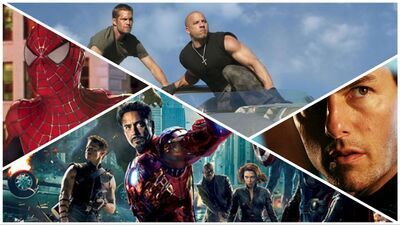
The 10 Best Start-of-Summer-Movie-Season Films of the 21st Century
Latest reviews.

Christy Lemire

Matt Zoller Seitz

The Roundup: Punishment
Simon abrams.

Jeanne du Barry
Sheila o'malley.

Peter Sobczynski

Covering the business and politics of space
Star Trek vs Star Wars Debate at 39th Space Symposium: Who Won?

- Click to share on X (Opens in new window)
- Click to share on Facebook (Opens in new window)
- Click to share on LinkedIn (Opens in new window)
- Click to share on Reddit (Opens in new window)
- Click to email a link to a friend (Opens in new window)
- Click to share on Clipboard (Opens in new window)

The clash of the titans finally happened, and it wasn’t between starships in a distant galaxy but rather between fervent fans of two of the most iconic science fiction franchises: Star Trek and Star Wars .
The battleground? The RedWire booth at the 39th Space Symposium , where passions flared, arguments flew and a winner was declared by none other than former NASA Administrator Jim Bridenstine himself.
Moderated by SpaceNews Senior Staff Writer Jeff Foust, the April 11 debate saw Team Star Trek, represented by Redwire Chief Growth Officer Mike Gold and NASA Chief Technologist A.C. Charania , go head-to-head with Team Star Wars, consisting of Jessica Noble , general counsel at iSpace Technologies U.S., and Camille Bergin, better known as The Galactic Gal .
The event was no mere clash of fandoms; it was a battle of ideologies, with each side arguing the merits of their beloved franchise. Team Star Trek argued for its optimistic vision of humanity’s future, spearheaded by the ideals of exploration, diplomacy and cooperation, as epitomized by the Federation and its starship crews. Team Star Wars, meanwhile, championed the epic saga’s timeless themes of heroism, destiny and the eternal struggle between light and dark, not to mention Ewoks , Han and Chewie .
Bridenstine, who dodged the “Star Trek or Star Wars?” quagmire during his tenure by citing Space Balls as his personal favorite, ultimately judged Team Star Wars to be the winner of the Redwire debate.
However, the outcome wasn’t without contention. Team Star Wars walked away with the victory, but the crowd audibly leaned in favor of the arguments put forth by Team Star Trek.
Watch and decide for yourself!
Who won the Star Trek vs Star Wars debate? — SpaceNews (@SpaceNews_Inc) April 12, 2024
Brian Berger
Brian Berger is editor in chief of SpaceNews.com and the SpaceNews magazine. He joined SpaceNews.com in 1998, spending his first decade with the publication covering NASA. His reporting on the 2003 Space Shuttle Columbia accident was... More by Brian Berger

Sign up for a SpaceNews newsletter
Get top stories, military space news and more delivered to your inbox.
Based on 2259 reviews
FREE U.S. Shipping
Free Shipping
We’re bringing the goods to you at no extra cost. Enjoy free U.S. shipping on every order, every day at Toynk.com. Valid for orders delivered within the contiguous United States only. Not applicable to Hawaii, Alaska, Puerto Rico, or U.S. Virgin Islands.
Earn Rewards While You Shop

- Action Figures
- Building Sets & Blocks
- Costumes & Accessories
- DIY & Model Kits
- STEM & Science Toys
- Vehicles & R/C Toys
- Arts & Crafts
- Board Games
- Brain Teaser Puzzles
- 100-Piece Puzzles
- 300-Piece Puzzles
- 500-Piece Puzzles
- 750-Piece Puzzles
- 1000-Piece Puzzles
- Adventure Puzzles
- Fantasy Puzzles
- Holiday Puzzles
- Retro Puzzles
- Travel Puzzles
- TV & Movie Puzzles

Buy 3, Get 1 Free

- Squishmallows
- Coffee Mugs
- Kitchen Tools
- Ramen Bowls
- Shot Glasses
- Travel Mugs
- Wine & Pint Glasses
- Advent Calendars
- Bathroom Extras
- Blankets & Throws
- Ceramic Planters
- Halloween Decor
- Snow Globes
- Storage Boxes
- Wall Art & Prints
- Books & Comics
- Notebooks & Journals
- Office Supplies
- Outdoor Goods
- Pool Toys & Games

- Hoodies & Sweaters
- Jackets & Outerwear
- Kitchen Aprons
- Leggings & Yoga Pants
- Robes & Pajamas
- Socks & Underwear
- T-Shirts & Polos
- Ugly Christmas Sweaters
- Belts & Suspenders
- Hats & Caps
- Keychains & Bag Clips
- Makeup & Prosthetics
- Ties & Cufflinks
- Wallets & Coin Purses
- Wigs & Beards
- Wrist Watches
- Backpacks & Bags
- Luggage Tags
- Lunch Boxes
- Adult Costumes
- Baby Costumes
- Child Costumes
- Costume Accessories
- Men's Costumes
- Teen Costumes
- Toddler Costumes
- Women's Costumes
- St. Patrick's Day
- Collectible Dolls
- Collectible Pins
- Geeki Tikis
- Prop Replicas
- Statues & Busts
- Vinyl Figures
- Baseball Cards
- Trading Cards
- Trading Sets

Garbage Pail Kids

- Adventure Time
- Back To The Future
- Black Panther
- Bob's Burgers
- Captain America
- Corpse Bride
- Game Of Thrones
- Golden Girls
- Harry Potter
- Hello Kitty
- Indiana Jones
- Jurassic Park
- Nickelodeon
- Nightmare Before Christmas
- Princess Bride
- Rick and Morty
- Sherlock Holmes
- Steven Universe
- Stranger Things
- Suicide Squad
- Angry Birds
- Assassin's Creed
- Call of Duty
- Five Nights At Freddy's
- Mass Effect
- Super Mario
- World of Warcraft
- Anime & Manga
- Coloring Books
- Disney Princess
- Heinz & Kraft
- Gifts for Him
- Gifts for Her
- Gifts for Kids
- Gifts for Dads
- Gifts for Moms
- Gifts for Students
- Gifts for Techies
- Gifts Under $10
- Gifts Under $20
- Gifts Under $40
- Gifts Under $50
- Gifts Under $75
- Gifts Under $100

- FANDOM FORCE REWARDS

Star Trek vs Star Wars: An Epic Sci-Fi Showdown
Star Trek is about deep space exploration with the Enterprise, while Star Wars is about epic battles between good guys and bad guys.
Both Star Trek and Star Wars movies are world-class, featuring cool characters and captivating science fantasy stories. But which is the best movie? Let's take a look at what makes Star Trek vs Stars special!
In the world of science fiction movies, two franchises standout from the crowd: Star Trek and Star Wars.
Star Wars & Star Trek Compared

When you compare Star Wars and Star Trek, you'll notice some big differences.
Star Trek is all about exploring space with the Starship Enterprise to find strange new worlds and promote peace.
Conversely, Star Wars is more about mystical elements, like the Force, and battles between good versus evil, like the Galactic Empire fighting the Rebel Alliance.
The Star Trek universe emphasizes moral dilemmas and scientific exploration, while the Star Wars galaxy leans toward action-packed narratives and mythic storytelling.
Both franchises have made significant impacts, offering unique perspectives within the science fiction genre.
The film Star Trek was originally a television series [ 1 ]. It follows an altruistic crew facing moral dilemmas, often contemporary social and political concerns.
Star Trek series tackles imperialism, war, racism, feminism, and human rights.
The central characters, including Captain Kirk, Spock, Scotty, Uhura, and Pavel Chekov, represent a blend of humans and humanoid alien species.
Despite its television roots, Star Trek achieved widespread recognition following the success of its films in 2009 and 2013.
Star Wars films draw heavily on fantasy archetypes like princesses, knighthood, and battles between the light side and the dark side.
The Star Wars universe incorporates political science elements and historical references.
The climax of the Rebel Alliance's struggle against the oppressive empire mirrors events from the fall of the Roman Republic and the rise of an empire.
Due to Star Wars' continued success, its creator, George Lucas, whom Hayden Christensen, a Star Wars actor called a "visionary," even produced an animated series, "Clone Wars."
It is a part of the franchise, set mainly between the events of Episode II: Attack of the Clones (2002) and Episode III: Revenge of the Sith (2005).
More on Star Wars vs Star Trek

Star Trek was created by Gene Roddenberry, which runs from 1966 to the present. In 1964, Gene Roddenberry began drafting the concept proposal.
While he pitched it as a space Western – a "Wagon Train to the stars" – privately, he revealed to friends that he drew inspiration from Jonathan Swift's "Gulliver's Travels."
His utopian vision aimed to create episodes that functioned on two levels: as thrilling adventures and as moral tales.
As mentioned, George Lucas created Star Wars, which runs from 1977 to the present. The concept does not prioritize realistic science; it is more about fantasy than strict science fiction.
Although the battle conflicts within the franchise were inspired by the Vietnam War, the central narrative is the "Force," an energy that permeates all life and can be wielded by characters with unique abilities.
The original series of Star Trek aired for three years in the late sixties after two pilots were made. Despite having dedicated fans, the show struggled with ratings and was eventually canceled.
There was only one cartoon series in the mid-70s [ 2 ] until the first Star Trek feature film revived the franchise in 1980.
This led to 11 more movies and several TV series until 2005. The 2009 and 2013 Star Trek reboot films by J.J. Abrams brought a fresh style and broad appeal.
In contrast, Star Wars is an original film in 1977, which became a global sensation. The Star Wars sequel trilogy happened followed every three years, with a prequel trilogy released 16 years later.
The sequel trilogy started from "Episode VII: The Force Awakens" (2015) to the "Episoce VIII: The Last Jedi" (2017) to the latest "Episode IX: The Rise of SkyWalker" (2019).
The reception of both franchises reflects the unique qualities of each franchise and their impact on popular culture.
Star Trek has cultivated a devoted following, which was praised for its optimistic vision of the future, diverse characters, and thought-provoking themes.
Despite initial struggles, it spawned multiple successful spinoffs and films.
In contrast, Star Wars burst onto the scene with universal acclaim, which captivates audiences with epic storytelling and iconic characters, like Darth Vader, Luke Skywalker, Boba Fett [ 3 ], and more.
While the original series garnered widespread praise, the prequel trilogy faced mixed reactions.
Both franchises continue to thrive with ongoing expansions and adaptations.
Star Trek is admired for its mind-blowing storytelling, while Star Wars is celebrated for its epic adventures, which leave incredible marks on fans and movie critics.
Social Elements
When envisioning the first season, Roddenberry aimed to inspire with a forward-thinking, liberal perspective, which reflects the cultural shifts of the 1960s.
While not openly discussed with television networks, Star Trek embodied Roddenberry's new hope for humanity's potential evolution, which emphasizes the importance of learning from past mistakes.
So, the first film of Star Trek has notably featured racially diverse characters to explore strange new worlds.
In comparison, Star Wars presents a classic tale of good (Luke Skywalker) versus bad (Darth Vader), with the Jedi representing the forces of good and the Sith embodying evil.
While it does not directly address specific social issues, it explores broader themes of light versus dark and authoritarianism versus democracy.
Even so, many have sought to draw parallels between the franchise and real-world historical and political contexts.
Star Trek boasts a dedicated fanbase known as "Trekkies," who attend conventions worldwide, donning costumes and engaging in discussions about the show.
Some fans even immerse themselves in the show's fictional language, Klingon.
In fact, a Star Trek-themed attraction in Las Vegas entertained visitors for a decade, while museum exhibits featuring props from the show have toured globally.
What's even more notable is a NASA space shuttle named after the USS Enterprise [ 4 ], which is the crew's iconic ship.
On the other hand, the Star Wars franchise has evolved into a vast universe of spinoffs and merchandise, like books, video games, TV movies, comics, and cartoon series (Clone Wars).
Numerous animal species have been named after Star Wars characters, which highlights its cultural impact. References to Star Wars are commonplace in films and the media, showcasing its enduring influence.
What is more realistic, Star Trek or Star Wars?
Star Trek is more realistic. It leans towards realism with a focus on science and technology, aiming for a plausible depiction of the future.
On the other hand, Star Wars prioritizes fantasy elements like the Force, making it less scientifically grounded.
Is Star Trek linked to Star Wars?
Star Trek and Star Wars aren't directly linked despite both being iconic sci-fi franchises. They have separate universes, personas, and storylines. However, they share similarities in themes and fanbase enthusiasm for the genre.
Final Thoughts
Each movie franchise has its strengths and appeal, and determining the best one is subjective. If asked, we would prefer Star Trek's scientific exploration, diplomacy, and optimistic vision of the future.
We like how it offers a thought-provoking examination of humanity's potential evolution. The franchise's focus is on the development of the show's protagonist and intellectual storytelling.
But if you prefer a more fantastical theme, Star Wars is a good pick. The epic space opera storytelling, iconic protagonists and villains, and timeless mythology are captivating.
If you're like us who prefers Star Trek's journey, explore Toynk's Star Trek merch collection to bring Starfleet Academy to life. Check out various toys and stuff inspired by Captain Kirk and the Alpha Quadrant!
References :
- https://www.britannica.com/biography/Gene-Roddenberry
- https://www.cnet.com/culture/entertainment/love-star-trek-lower-decks-give-the-70s-star-trek-animated-series-a-try/
- https://starwars.fandom.com/wiki/Boba_Fett
- https://www.nasa.gov/history/45-years-ago-space-shuttle-enterprise-makes-its-public-debut/
Continue reading
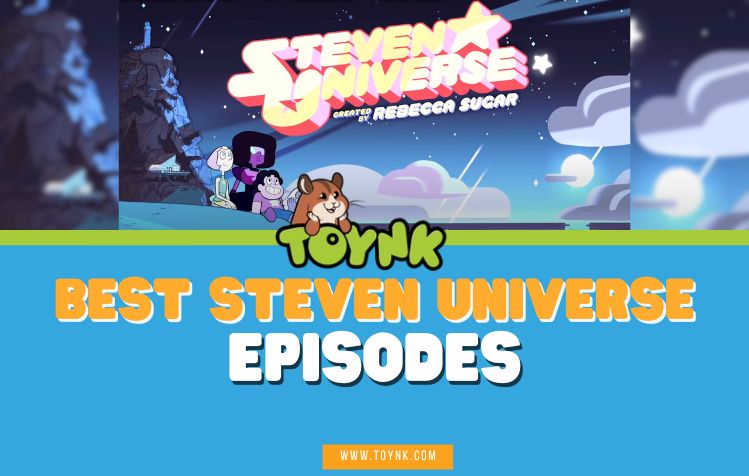
10 Best Steven Universe Episodes You Shouldn't Miss (2024)
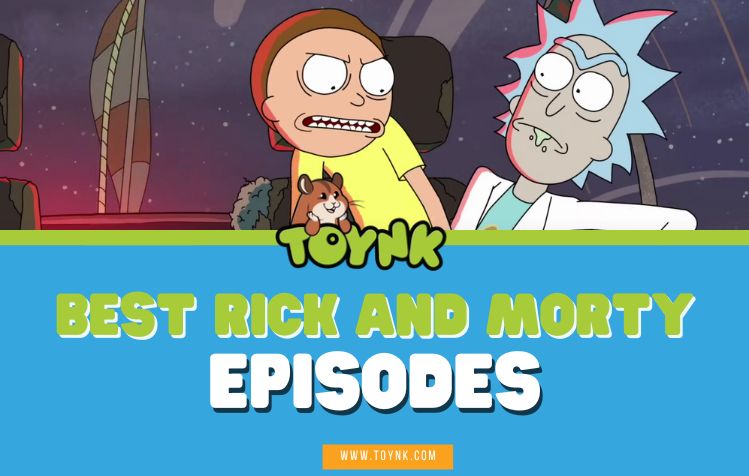
10 Best Rick & Morty Episodes: The Ultimate Must-Watch List
Leave a comment
All comments are moderated before being published.
This site is protected by reCAPTCHA and the Google Privacy Policy and Terms of Service apply.
Free U.S. Shipping
Free shipping for every order, every day for the contiguous U.S.
Help Center
We are available Monday - Friday to answer your questions at [email protected]
Secure Payment
Your payment information is processed securely
Need to contact us? Just send us an e-mail at [email protected]
The Star Wars Franchise Is In Its 'Star Trek: The Next Generation' Era
People inevitably compare Star Wars and Star Trek, and the former's evolution as a franchise is akin to The Next Generation era of its development.
- Star Trek and Star Wars are naturally compared by fans despite being entirely different sci-fi animals.
- Both have longevity, but Star Wars is at a place in its growth as a franchise akin to The Next Generation for Star Trek.
- The biggest difference is how fandom influenced the first Star Trek and Star Wars projects made without their creators.
From their titles to their primary setting being space, people naturally compare Star Trek and Star Wars despite their major philosophical differences. Put simply, Gene Roddenberry's universe is about building the perfect institution. George Lucas's universe, on the other hand, is about how every institution will eventually fail. Yet, since both properties are themselves cultural institutions, Star Wars should hope Star Trek 's view is the right one where franchises are concerned. Both are in their "third wave" of new releases, but Star Wars ' evolution is more akin to Star Trek: The Next Generation . Part of the reasons these space-based fantasies endure through generations is that, as Luke Skywalker said, they are never "really gone." Kids rewatch the installments they love as they grow up.
They then share it with their kids, usually in time for a new release in the franchise. Fans are also very particular about what they like in these universes, with heavy skepticism to outright disdain meeting each new entry in the canon. Yet, while Star Trek is exploring many different avenues with shows like Star Trek: Discovery , Strange New Worlds and Lower Decks , Star Wars is still trying to figure out its answer to The Next Generation . When Roddenberry brought the upgraded USS Enterprise to TV in 1987, there was no guarantee it was going to work. When the Great Bird of the Galaxy suddenly passed away, executive producer Rick Berman and company had to go on without him. Thankfully, George Lucas is alive and well. He traded the stress of making Star Wars to Disney for $4 billion. If Star Wars is going to endure like Star Trek , it's a crucial time in the franchise's evolution.
Why George Lucas Removed Star Wars' Strangest Jedi Master
Breaking Down the 'Phases' of Star Wars and Star Trek
Star Trek: The Original Series is very much akin to the Star Wars original trilogy . They were two space epics that needed impossible-for-the-time visual effects. They were stories that were about something meaningful but dressed in the trappings of science fiction and fantasy. There weren't many "stars" to attract casual audiences. While it happened at a different pace, both Star Trek: The Original Series and the first three Star Wars films proved everyone wrong. They weren't just successful financially, they touched viewers' hearts in a powerful way. After the initial run, it was a matter of "when" not "if" the characters would return.
With no disrespect to the Legends expanded universe, Star Wars only returned 'for real' with the prequel trilogy . It was like nothing fans had seen before, but with more installments and time, most warmed up to the story being told. This progression is similar to Star Trek: The Motion Picture , which was only greenlit by Paramount after the success of A New Hope and Close Encounters of the Third Kind . The sequels, mostly produced by Harve Bennett, told a serialized story and won over audiences old and new.
Roddenberry knew The Next Generation had to be completely different from the first show. Visually, the prequels fit that description. Yet, unlike The Next Generation , the prequel trilogy was directly connected to what came before. Even Star Wars: The Clone Wars TV series was tied closely to the original saga and took place in between the second and third films in the trilogy. In both cases, the franchise's visionary creators lost control of their universes. It was up to new storytellers to carry on their legacy. They had to create something that was equal parts new and familiar -- a target that's more difficult to hit than a two-meter exhaust port on the Death Star.
Star Trek's Jonathan Frakes Says There's a 'Real Opportunity' to Make a TNG Sequel Series
What Happens When Fans Take Over Star Wars and Star Trek
Star Trek 's creator was heavily involved in the creation of The Next Generation . The show had a tumultuous start, from losing the ship's doctor to the ever-rotating writing staff. Much like George Lucas during the making of The Empire Strikes Back , Roddenberry would offer approval on story or character ideas, but the bulk of the creative work was done by other artists. By the time Deep Space Nine made Star Trek a franchise in the truest sense of the term, it was executive producers Rick Berman, Michael Piller, Jeri Taylor and others responsible for shaping the universe.
The biggest difference between the evolution of Star Trek and Star Wars is the people in charge of the former weren't fans, while the latter is filled with them. Sure, Star Trek had their Trekkies behind-the-scenes from writer Ronald D. Moore to production designers Doug Drexler, Michael and Denise Okuda . However, many of the people calling the shots, especially Rick Berman, weren't nostalgic for The Original Series . Everything from Star Wars: Rebels to the "Mando-verse" comes from writers, directors and other artists who adore Star Wars . Led by George Lucas's protégé Dave Filoni, these new storytellers are trying to shape the future of the galaxy in the image of its creator.
Individuals like Berman and Piller may not have grown up loving Kirk, Spock, and McCoy, but they did revere Gene Roddenberry. He was a tough person to work with by all accounts, but the people in charge tried to ensure their vision of the future fit squarely into Gene Roddenberry's "box" . Star Wars is where Star Trek was in the mid-to-late 1990s. It feels inevitable, but the parent studio might lock it in the vault when fans least expect it.
Star Wars Comics Are Returning To The Prequel Era
Star Wars Fans Could Stand to Be a Little More Like Trekkies
Shows like Deep Space Nine , Star Trek: Voyager and Enterprise were all very popular. Today their ratings (often in the tens of millions) would make the shows the most massive hit on television. Even back then, the ratings were respectable. Star Trek: Enterprise was supposedly canceled for low ratings, but it remained the highest-rated show on the United Paramount Network until it was replaced by The CW. Despite this on-paper success, fans greeted every new Star Trek iteration with skepticism or outright derision.
The first season of The Next Generation was widely panned by the larger fanbase. Yet, they still tuned in each week. Even though they didn't like the first season, they watched the show to "buy" a second chance. Star Wars may not be so lucky. Deep Space Nine never earned the ratings or popularity the studio hoped for, much like Star Wars ' emotionally heavy, morally gray political drama Andor . Berman-era Star Trek stayed the course, for better or worse, pursing ideas the storytellers thought were cool with little concern for what fans wanted.
Yet, because these storytellers are fans of Star Wars , the question of "fan service" is relevant. Star Trek: Picard 's showrunner for two of its three seasons, Terry Matalas, got his start in the business on the Berman-era shows. Any fan service in Picard , especially Season 3, was included because the Trek fans writing the story thought it was cool. Like any good Jedi, Star Wars storytellers have to strike the right balance of indulging their whims as fans and evolving the universe in a meaningful and interesting way.

- Mirror Universe
- View history

The alternate USS Enterprise at warp
Warp drive or warp engine was a technology that allowed space travel at faster-than-light speeds . It worked by generating warp fields to form a subspace bubble that enveloped the starship , distorting the local spacetime continuum and moving the starship at velocities that could greatly exceed the speed of light . These velocities were referred to as warp factors . Warp drive was the most common form of interstellar propulsion used in the Milky Way Galaxy , making interstellar civilization, exploration, and commerce possible. By the 24th century, warp was the primary means of interstellar transport , but scientists from various cultures were pursuing various alternative propulsion methods that were hypothetically faster or more efficient.
- 1 Etymology
- 2.1 Parts of the system
- 2.2 System types
- 3.1 21st century
- 3.2 22nd century
- 3.3 23rd century
- 3.4 24th century
- 3.5 ...and beyond
- 4.1 Background information
- 4.2 External links
Etymology [ ]

The USS Discovery at warp in 2257

The USS Stargazer performs a warp jump
In 2063 , the term "warp drive" was already used by Zefram Cochrane of his engine on the Phoenix . However, Cochrane used the term "space warp generator" in the monitor displays on his spacecraft. ( Star Trek: First Contact ) Even as late as the 2150s , the warp five engine was still officially known as a " gravimetric field displacement manifold" ( ENT : " Cold Front ").
Most cultures throughout the Milky Way Galaxy used the term "warp drive" and by the late- 23rd century it was the most common term used by the Federation as well ( Star Trek: The Original Series , et al.). In the 2250s the term "hyperdrive" was used by Starfleet , ( TOS : " The Cage ") and the Ferengi occasionally used the term "lightspeed drive". ( TNG : " Peak Performance ") Finally, there was the term "star drive" which was only used by the Federation and Starfleet in the 2260s. ( TOS : " Bread and Circuses ", " The Paradise Syndrome ")
Space warp was one of the vocabulary words listed on the chart "A Tunnel in the Sky". This chart was seen in the schoolroom aboard Deep Space 9 in 2369 . ( DS9 : " In the Hands of the Prophets ")
The process of going to warp was described as a warp jump . ( ENT : " Horizon "; TNG : " Peak Performance ", et al.)
Technology [ ]
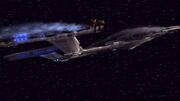
Enterprise with a disabled warp engine
Warp engines were the bulky units found, in many cases, in a starship's nacelle . ( TNG : " New Ground ")
24th century Federation warp engines were fueled by the reaction of matter ( deuterium ) and antimatter ( antideuterium ), mediated through an assembly of dilithium crystals, which were nonreactive with antimatter when subjected to high-frequency electromagnetic fields . This reaction produced a highly energetic plasma , called electro-plasma or warp plasma , which was channeled by plasma conduits through the electro-plasma system (EPS); that system also provided the primary energy supply for the ships other electronic systems. For propulsion the electro-plasma was funneled by plasma injectors into a series of warp field coils , usually located in remote warp nacelles . These coils were composed of verterium cortenide and generated the warp field .
Other civilizations used different power sources, such as the Romulans ' use of artificial quantum singularities to power their warp drives, ( TNG : " Timescape ") but the basic process was similar. In some vessels, such as the Intrepid -class , the nacelles were mounted on variable geometry pylons . ( VOY : " Caretaker ")
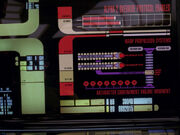
A display showing the main components of a warp drive
Parts of the system [ ]
- Antimatter containment
- Antimatter inducer
- Antimatter relay
- Deuterium cartridges
- Deuterium control conduit
- Electro-plasma
- Emergency shutdown trips
- Main stage flux chiller
- Magnetic interlock
- Bussard collectors
- Plasma injector
- Nullifier core
- Pre stage flux chiller
- Phase inducer
- Plasma conduit
- Plasma coolant
- Plasma regulator
- Power transfer conduit
- Power transfer grid
- Space matrix restoration coil
- Warp field generator
- Warp plasma conduit
- Antimatter injector
- Antiproton injection seal
- dilithium articulation frame
- dilithium chamber hatch
- dilithium crystal
- dilithium regulator
- Intermix chamber
- Matter injector / deuterium injector
- Theta-matrix compositor
System types [ ]
- Class 7 warp drive
- Class 9 warp drive
- Enhanced warp drive
- S-2 graf unit
- Subspace resonator
- Tetryon plasma warp drive
- Tricyclic plasma drive
- Warp five engine
- Warp three engine
- Yoyodyne pulse fusion
Development [ ]
Warp drive and other faster-than-light (FTL) propulsion technologies were the linchpin of an interstellar civilization, making trade and exploration across vast interstellar distances viable. Without these technologies, these distances could not be crossed in any reasonable period of time, making interstellar civilization usually limited to a single sector. ( TNG : " A Matter Of Time ") To put this in perspective, planets that were years away with impulse speeds could be reached in days with ships equipped with warp drive. ( TOS : " Where No Man Has Gone Before ")
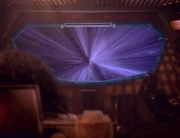
The IKS Rotarran accelerates to warp, viewed from within the vessel
Cultures in the galaxy discovered warp drive at their own pace and rate of development, as most of the cultures had to do. The Vulcans were an interstellar civilization by 9th century BC and had reached the level of warp 7 by 2151 . ( ENT : " The Andorian Incident ", " Fallen Hero "; DS9 : " Little Green Men ") Klingons had interstellar travel capability around the time of Kahless in the 9th century . They had achieved the capability of warp 6 by 2151. ( TNG : " Rightful Heir "; DS9 : " Little Green Men "; VOY : " Day of Honor "; ENT : " Judgment ") Romulans were once considered a group of petty thugs and warp drive was regarded as the key technology that allowed the founding of the Romulan Star Empire . ( Star Trek: Insurrection ) The Vissians developed warp drive around the 12th century . ( ENT : " Cogenitor ") The Borg in the Delta Quadrant began to establish their interstellar collective by the 15th century . ( VOY : " Dragon's Teeth ") In the Alpha Quadrant, the rapid progress of Humanity in the 22nd century led to the wide-scale exploration of the galaxy being one of the basic goals of the United Federation of Planets , founded in 2161 .
The development of the warp drive was recognized by the United Federation of Planets as the marker of an advanced society. It was only after a people developed warp drive that the Federation made contact, as codified in the Prime Directive . ( TNG : " First Contact ") A warp capable society was deemed technically and psychologically ready to embrace the universe at large.
According to Science Officer Spock in 2259 , not once in the entire history of first contact had warp been first developed as anything but a drive. However, the Kiley had developed warp in the form of a warp bomb . ( SNW : " Strange New Worlds ")
21st century [ ]

Phoenix goes to warp
On Earth , warp drive was initially developed by Zefram Cochrane , in the period following World War III . ( Star Trek: First Contact )
The spacecraft credited with discovering the space warp phenomenon was the Bonaventure . ( DS9 : " The Nagus ", production art )
Despite the hardships imposed by the war's aftermath and the lack of advanced materials, Cochrane was able to build a manned warp-capable vessel using a converted Titan II missile. The successful first flight of his ship – the Phoenix – took place on April 5 , 2063 , and drew the attention of a Vulcan exploratory vessel, leading to the event known as First Contact . ( Star Trek: First Contact )
The Bonaventure then became the first deep-space starship to have warp drive installed. ( TAS : " The Time Trap ")
22nd century [ ]
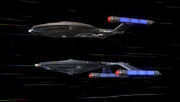
Two NX-class starships in tandem warp flight
Development of warp technology by humans proceeded slowly over the next eighty years, after the flight of the Phoenix – due, in no small part, to the cautious advice of the Vulcans – and it was not until the 2140s that a warp engine developed by Henry Archer at the Warp Five Complex could exceed warp factor 2.
This engine was successfully tested in the second NX prototype by Commanders A.G. Robinson and Jonathan Archer to a speed of warp 2.5, breaking the so-called " warp 2 barrier " in 2143 . Eight months later, Duvall achieved warp 3 with the NX Delta . Warp 4 was first achieved by the USS Franklin . ( ENT : " First Flight "; Star Trek Beyond )
By the year 2149 , warp technology was sufficiently advanced to begin the construction of Enterprise , a vessel capable of warp 5 and launched in 2151 . ( ENT : " Broken Bow ") Although Enterprise was at first unable to fully realize this potential (maxing out at warp 4.7), the starship finally reached warp 5 on February 9 , 2152 . ( ENT : " Fallen Hero ")
By 2161 , Starfleet warp drive technology had achieved the capability to reach warp 7, and these engines were being built into the latest class of Starfleet vessels as the NX-class ships were being decommissioned. ( ENT : " These Are the Voyages... ")
23rd century [ ]

The USS Shenzhou at warp in 2256
Development and improvement of warp drive continued apace, and by the 2240s , Starfleet vessels of the Constitution -class had standard cruising speeds of warp 6 and emergency speeds as high as warp 8 (although under the right conditions, the engines could reach warp 9). These ships took advantage of a major breakthrough in warp technology that took place between 2236 and 2254 , the breaking of the so-called " time barrier ". ( TOS : " The Cage ")
Higher warp factors continued to be reached, mostly through alien intervention, or dangerous malfunction. The USS Enterprise was modified by the Kelvans to maintain a speed of warp 11 in 2268 . Later that year, the Enterprise accelerated to a speed of warp factor 14.1, after being sabotaged by a Kalandan planetary defense system . At that velocity, however, the ship came within moments of destroying itself. ( TOS : " By Any Other Name ", " That Which Survives ")
At around the same time, warp engines were being redesigned to allow standard speeds of warp 8 and above. During the refit of the Constitution -class, the cylindrical-shaped nacelles were replaced with a new flattened design. Engines required precise tuning; imbalanced engines caused a wormhole effect that almost destroyed Enterprise on its first mission after refit. ( Star Trek: The Motion Picture )

The USS Enterprise -A jumps to warp to escape an incoming photon torpedo
Warp theory continued to advance with the development of the first transwarp drive engines in the mid- 2280s , which would have theoretically allowed greater efficiency and any warp speed to be available for a ship. However, the transwarp experiment of USS Excelsior ended in failure, and the technology was abandoned at that time. The Excelsior itself was deemed spaceworthy, retrofitted with conventional warp drive and commissioned as NCC-2000 under the command of Captain Hikaru Sulu . ( Star Trek III: The Search for Spock ; VOY : " Threshold "; Star Trek VI: The Undiscovered Country )

24th century [ ]
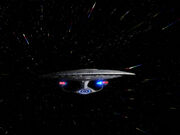
The USS Enterprise -D at warp
At some point in the 24th century, a new warp factor scale came into use, which placed warp 10 as a theoretical maximum. ( VOY : " Threshold ")
By the time the Galaxy -class starship was being designed in the 2360s , warp technology had progressed to the point where speeds of warp 9.6 could be sustained for up to twelve hours, although warp 9.2 was considered the "red line." ( TNG : " Encounter at Farpoint ")
In 2367 , the warp drive on the Galaxy -class starship was managed by the warp propulsion power system . In that year, when Data hijacked the USS Enterprise -D , he issued a command override on this system giving him complete control of the system from the bridge . ( TNG : " Brothers ")
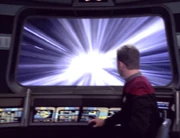
Voyager accelerates to warp
The USS Voyager was capable of a top cruising speed of warp 9.975. ( VOY : " Caretaker ", " Relativity ")
The USS Prometheus was capable of a sustained cruising speed of warp 9.9. ( VOY : " Message in a Bottle ")
In 2370 , the Hekaran scientist Serova discovered that the use of conventional warp engines caused damage to the fabric of spacetime. The Federation Council imposed a speed limit of warp factor 5 on all Federation vessels in all but extreme emergency cases, such as medical emergencies. A conspiracy theory posit by Steve Levy suggested that the discovery of this was part of a Vendorian morality test ( TNG : " Force of Nature ", " The Pegasus ", " Eye of the Beholder ", LD : " Caves ")
It was not until 2372 , that the transwarp threshold was broken by the Federation. Tom Paris of the USS Voyager managed to achieve infinite velocity on the shuttlecraft Cochrane . However, this form of travel was found to have severe, unanticipated side effects . ( VOY : " Threshold ")
...and beyond [ ]
In what was originally the future which was observed and altered by Jean-Luc Picard , speeds of at least warp 13 were possible. ( TNG : " All Good Things... ")
Appendices [ ]
Background information [ ].
Gene Roddenberry originally intended the Enterprise to become transparent while in warp drive, as depicted in " The Cage " (later reformatted into the two-part "The Menagerie"). The idea was that the ship would be traveling faster than light, which means that light would not reach it, rendering the vessel invisible to the naked eye. However, according to Einstein's Theory of Special Relativity, the speed of light is a constant from any frame of reference; an observer moving at close to c would still observe light moving toward him and away from him at c .
External links [ ]
- Warp drive at StarTrek.com
- Warp drive at Memory Beta , the wiki for licensed Star Trek works
- Hyperdrive at Memory Beta , the wiki for licensed Star Trek works
- Warp drive at Wikipedia
- André Bormanis's explanation of warp drive (X)
- 3 ISS Enterprise (NCC-1701)
- Cast & crew
- User reviews

In the 23rd Century, Captain James T. Kirk and the crew of the U.S.S. Enterprise explore the galaxy and defend the United Federation of Planets. In the 23rd Century, Captain James T. Kirk and the crew of the U.S.S. Enterprise explore the galaxy and defend the United Federation of Planets. In the 23rd Century, Captain James T. Kirk and the crew of the U.S.S. Enterprise explore the galaxy and defend the United Federation of Planets.
- Gene Roddenberry
- William Shatner
- Leonard Nimoy
- DeForest Kelley
- 277 User reviews
- 99 Critic reviews
- 16 wins & 31 nominations total
Episodes 80

Photos 1999

- Captain James Tiberius 'Jim' Kirk …

- Mister Spock …

- Lieutenant Leslie …

- Nurse Chapel …

- Ensign Freeman …

- Yeoman Rand …

- Announcer …
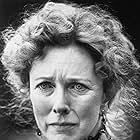
- Beta 5 Computer …
- Security Guard …
- All cast & crew
- Production, box office & more at IMDbPro
Stellar Photos From the "Star Trek" TV Universe

More like this

Did you know
- Trivia In the hallways of the Enterprise there are tubes marked "GNDN." These initials stand for "goes nowhere does nothing."
- Goofs The deck locations for Kirk's Quarters, Sickbay and Transporter Room vary (usually between decks 4-7) throughout the series.
Dr. McCoy : "He's dead, Jim."
- Crazy credits On some episodes, the closing credits show a still that is actually from the Star Trek blooper reel. It is a close-up of stunt man Bill Blackburn who played an android in Return to Tomorrow (1968) , removing his latex make up. In the reel, He is shown taking it off, while an off-screen voice says "You wanted show business, you got it!"
- Alternate versions In 2006, CBS went back to the archives and created HD prints of every episode of the show. In addition to the new video transfer, they re-did all of the model shots and some matte paintings using CGI effects, and re-recorded the original theme song to clean it up. These "Enhanced" versions of the episodes aired on syndication and have been released on DVD and Blu-Ray.
- Connections Edited into Ben 10: Secrets (2006)
- Soundtracks Star Trek Music by Alexander Courage
User reviews 277
- May 6, 2003
- How do they maintain Gravity on the the U.S.S. Enterprise ? .
- All aliens on all planets speak the English language?
- What does "TOS" mean?
- September 8, 1966 (United States)
- United States
- Star Trek: The Original Series
- Backlot, Culver Studios - 9336 W. Washington Blvd., Culver City, California, USA
- Desilu Productions
- Norway Corporation
- Paramount Television
- See more company credits at IMDbPro
Technical specs
- Runtime 50 minutes
Related news
Contribute to this page.
- IMDb Answers: Help fill gaps in our data
- Learn more about contributing
More to explore

Recently viewed
Den of Geek
What Modern Star Wars Needs to Learn From Star Trek
It doesn't take the wisdom of a Jedi to see that Disney needs to take a page out of Star Trek's book to put Star Wars back on top.

- Share on Facebook (opens in a new tab)
- Share on Twitter (opens in a new tab)
- Share on Linkedin (opens in a new tab)
- Share on email (opens in a new tab)
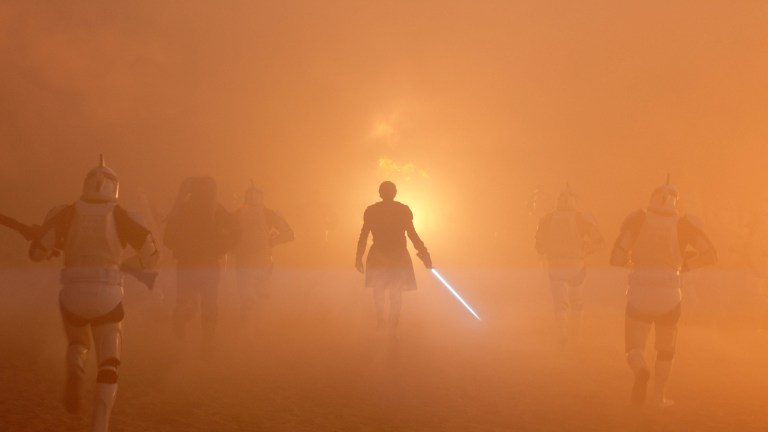
Way back in 2002, the excitement for Star Wars Episode II: Attack of the Clones diminished somewhat. Late Night with Conan O’Brien sent Triumph the Insult Comic Dog to mock the fans lined up for the premiere, resulting in a segment in which comedian/puppeteer Robert Smigel launched nerd jokes at the assembly.
Most of the jokes were pretty obvious, including the last bit, in which a man cosplaying as Mr. Spock gained the knack for cursing and walked up and down the line with his middle finger extended. But while the perceived Star Wars vs. Star Trek rivalry has become an old toxic cliché at this point, the fact is that the two franchises don’t actually overlap very much in terms of their core missions. Trek favors optimistic philosophical inquiry and Wars emphasizes fantasy and adventure.
In fact, in their decades-long history, Star Wars and Star Trek haven’t actually directly clashed all that often (although the early ’80s of The Empire Strikes Back followed by Wrath of Khan was undoubtedly a golden age for sci-fi movie nerds), and the two franchises rarely enjoy success at the same time, with the Star Wars movies usually debuting during a dry point for Star Trek , and Trek dominating television while Wars flounders.
Except for now. In the past few years, both Star Wars and Star Trek entries have hit theaters and televisions on a regular basis. And while the two franchises have had their respective highs and lows, Trek has hit a stride with Strange New Worlds , Lower Decks , and Picard ‘s third season while Wars has mostly been on a downward spiral in popularity and quality (except for Andor , of course) following the first two seasons of The Mandalorian .
Ad – content continues below
Of course, history shows the scales could tip the other way at any moment, but for those of us who want both franchises to do well (full disclosure: this author is far more of a Trekkie than a Wars fan), there are a few lessons that Wars could take from Trek ‘s recent success to bring the galaxy far, far away back to its former glory.
Serve More Than One Kind of Audience
Okay, before getting angry and going straight to the comments, there are absolutely examples of recent Star Wars entries that aren’t entirely focused on one kind of fan. Andor eschews much of the core fantasy element of the franchise for a more adult spy drama, while Young Jedi Adventures is aimed squarely at a new generation of fans. Meanwhile, the anthology series Visions lives up to its name by presenting radically different takes on the universe from fresh perspectives.
However, it’s also true that the majority of recent Star Wars output – Mando season 3, Ahsoka , Obi-Wan Kenobi , parts of Boba Fett , both Tales animated series, The Bad Batch , etc. – is pitched directly at a specific kind of fan with love for and extensive knowledge of the Prequels and The Clone Wars animated series. Those fans tend to be millennials of a certain age who grew up with those films and, unfortunately, almost nobody else. So while some viewers cheer when Bo-Katan becomes the lead of The Mandalorian because they know her history with the Darksaber and Mandalore, others despair that the Western/ronin motifs faded away for The Clone Wars lore. It’s not just that the latter fans have no attachment to these characters. It’s that The Mandalorian and its spinoffs don’t really work to ingratiate The Clone Wars characters to those unfamiliar with them, instead aiming the storytelling directly at those nostalgic for The Clone Wars days.
To be sure, Star Trek has its own arcane references, as the opening shot of Picard ‘s premiere shows or the name “ Sybok ” coming up on Strange New Worlds . However, the most recent crop of Star Trek shows work because they aim for a wide range of audiences.
Prodigy is a kid’s show that picks up on plot threads from Voyager but primarily deals with a group of young aliens from different cultures learning to work together. Discovery is all big adventure and operatic emotion for fans whose introduction to the franchise was the J.J. Abrams movies. Strange New Worlds features classic characters from The Original Series and a return to philosophical conundrums, while Lower Decks makes in-jokes for long-time fans.
With the announcement of a Rey movie , Star Wars is taking steps in the right direction by making something for younger fans who grew up with the Sequel Trilogy , while The Mandalorian & Grogu is positioned to bring back to the big screen the Western aesthetic Original Trilogy fans loved so much from the first two seasons of the show. However those movies turn out (if they come out at all), the franchise would do well to remember its audience doesn’t consist of just one type of fan.
Star Trek TV creative head Alex Kurtzman said it best when talking about that universe’s approach to catering to different types of fans: “Our biggest thing has honestly been we don’t ever want our Star Trek shows to feel repetitive. We don’t want you to think that by watching Discovery , you shouldn’t watch any of the other shows because you’re getting everything from that one show. Each show is different,” Kurtzman continues. “So for us, it’s not about doing one show that pleases everybody because that’s the surefire way to please nobody. It’s more about doing a bunch of different shows that speak to specific sections of the demographic.”
Get the best of Den of Geek delivered right to your inbox!
Be Careful With Nostalgia
However, while Star Wars would do well to build on the worlds of all three trilogies, it should not simply focus on nostalgia. Yes, that does sound like a laughable suggestion from a Trek perspective, given the third season of Picard . However, Picard worked because it used nostalgia in exactly the same way that Star Wars fans rejected. When Luke Skywalker tosses the lightsaber at the start of The Last Jedi , he appalled many older fans of the Original Trilogy.
And yet, that’s very similar to how Star Trek treated Jean-Luc Picard in the widely-acclaimed final year of his solo series. While the first two seasons leaned too hard into tearing down the one-time paragon, the third season found the perfect balance. On the USS Titan, Picard showed signs of the leadership and wisdom that made him great on The Next Generation , but he also showed maturity and a willingness to learn. Throughout the third season, characters such as Geordi and Ro Laren aired reasonable grievances with Picard. And by hearing them and admitting his faults, faults that once made TNG audiences cheer, Picard grows into a more interesting character.
It was a pitch-perfect send-off that also gave way to the potential future of the franchise, with a new Enterprise christened and ready to set off on a new voyage. And it did what the Sequel Trilogy hoped to do: effectively passed on the torch to a new generation of Starfleet officers.
Contrast that treatment of Picard to one of the least controversial callbacks in recent Star Wars history. When Rey and Finn board the Millennium Falcon in The Force Awakens , they’re greeted by Han and Chewie, back to being the scoundrel smugglers they were in Episode IV , zero growth or change on display besides their age. Sure, Han will later briefly apologize to Kylo Ren for his failures as a father, but that’s never expressed visually on screen. And as nice as it is to see Harrison Ford call up the charisma that makes him great, his older Han is a cypher, just one more callback to the original Star Wars in a movie that plays like a cover song.
If Star Wars intends to build out its universe on the bones of the Skywalker Saga, then it needs to acknowledge that its popular characters have to grow and change over time. Rian Johnson had the right approach with Luke in The Last Jedi , whether certain fans warmed to the character’s new status quo or not. Of course Luke had to change, grow, and embrace new lessons, that’s how characters work, especially when the mission was clearly to pass the torch to the next trio of heroes. It’s too bad The Rise of Skywalker went back to playing the hits and embedding its next generation of heroes in a Star Wars story that had already been told countless times before.
Don’t Be Precious
For as much as it’s important to respect the growth of legacy characters over time, it’s also important to remember that these franchise are fundamentally fun and silly. Sure, we all have deep feelings about the interior lives of Morn from Deep Space Nine and Dexter Jettster from Attack of the Clones , but, you know, one is a Cheers nod and the other is a classic hash-slinger. So lighten up a bit.
Star Wars has certainly poked fun at itself with the Family Guy Blue Harvest episodes and Lego Star Wars specials. But the unaired Star Wars Detours still stands as a missed opportunity to indulge in the nerdy stuff while showing the funnier side of all that lore. If that’s a name you haven’t heard for a long time, Detours was a collaboration between Lucasfilm and the Robot Chicken team, resulting in the same irreverent but knowing humor of the latter show. Although the team completed 39 episodes, the series was “paused” in 2013 with none making it to air.
Many Star Wars fans consider Detours a lost grail, a feeling only increased by the success of Star Trek: Lower Decks , which makes fun of every single part of Trek lore, from the franchise’s tendency to set episodes in nondescript caves to the strange relationship between the reboot movies and the rest of the show. Absurd things that Star Trek would rather forget, including dumb merchandise and reusing actors for major roles, appear in Lower Decks .
Lower Decks has a great voice cast and strong storytelling beyond its gags, but it also works because the humor rewards people obsessed with Star Trek . There’s a communal aspect to getting a joke about Kzinti posture or cheering whenever Kurtwood Smith or J.G. Hertzler make a vocal appearance. It turns what could be one of the most toxic parts of fandom into something celebratory.
It could definitely be argued that certain Star Wars fans are perhaps a little too hung up on taking “the canon” seriously. Wouldn’t it be nice if we could also have a laugh about it every once in a while? Lower Decks shows that making fun of its universe is just another form of love.
Do a Musical
Quick, what’s the best Star Wars song? It’s probably “Yoda” by Weird Al Yankovic , maybe “The Saga Begins,” right? Something by Nerf Herder? The Yoda “Seagulls” song?
Now, what’s the best official Star Wars song? If we’re not counting the legendary John Williams scores, the possibilities get slim right away. I’m sure there are some real “jizz” music fans out there, but it doesn’t have the wider appeal of, say, a musical.
Look at the critical acclaim Star Trek received with its musical episode “ Subspace Rhapsody ” from the second season of Strange New Worlds . In that episode, an alien transmission forces the crew to sing out all of their thoughts, resulting in unlikely musical numbers, including Klingons doing their best BTS impression.
Even those who didn’t love “Subspace Rhapsody” (this writer, for example) have to admit that the episode did a lot to push the franchise into new territory with a completely different flavor of storytelling, all while highlighting a cast that includes Tony-nominated and Grammy-winner Celia Rose Gooding. “Subspace Rhapsody” further proves that Trek can handle a wide range of genres.
As a space opera, Star Wars lends itself to the over-the-top emoting that makes for a great musical. And while horrid entries, such as “Jedi Rocks” from the special edition of Return of the Jedi and “I’m Han Solo” from Kinect Star Wars Dancing , still haunt the nightmares of fans, it’d be nice to see the galaxy far, far away pull off something this bold in the future.
Return of the Good Sci-Fi
While it’s true we’ve largely favored Trek over Wars here, the fact of the matter is that the success of and shortcomings of the other are only temporary. Wars seems poised to right the ship by putting a Mandalorian movie in theaters, hopefully returning the focuse on breakouts Din Djarin and Baby Yoda. Moreover, Paramount seems to have nothing but terrible ideas in store for the future of Star Trek , including canceling Lower Decks , learning too heavily on the Section 31 corner of the universe, and making a wrongheaded origin film .
To be clear: neither franchise is inherently better than the other, and both have to deal with boardrooms whose pursuit of money can lead to terrible storytelling decisions. But some of the best entries in either franchise have come when one universe learns from the other, as demonstrated by the adventure-heavy Star Trek II: The Wrath of Khan and the philosophically-rich Andor .
Latest TV reviews
The responder series 2 review: the opposite of cosy crime, star trek: discovery season 5 episode 6 review – whistlespeak, shardlake review: sinister and satisfying tudor-set murder mystery.
So as the fortunes of each franchise continue to change, we can only hope that the creatives behind our favorite stories will learn from each other. That’s the only way we’ll get more great art, whether we have to boldly go to find it or search a long time ago, in a galaxy far, far away.

Joe George | @jageorgeii
Joe George’s writing has appeared at Slate, Polygon, Tor.com, and elsewhere!
The history of the Jedi Order in 'Star Wars'
All aboard this lightspeed tour of the history of the Jedi Order, the peacekeepers of the galaxy.
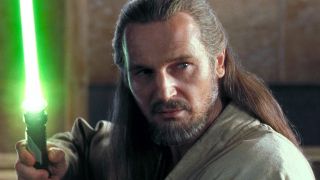
- Origins of the Jedi
- Old Republic times
- High Republic / Golden age of the Jedi
- Fall of the Jedi / Clone Wars
- Dark times / Return of the Jedi
- New Republic era / the Last Jedi
One of the core pillars of Star Wars is the Jedi and their mysterious connection to the Force, but we've only seen fragments of their illustrious order's history on the big screen. Watching the Star Wars movies in chronological order , we see them at the height of their power, fall into near extinction, and rise once again. Now, with the new live-action series The Acolyte on Disney Plus, we're about to learn how the Sith plotted in the shadows against the Jedi prior to the events of The Phantom Menace. Before the series arrives, here's the complete history of the Jedi Order.
Star Wars is especially interested in the fight between the forces of light and darkness across generations, and the history of both the Jedi and Sith Orders is long and often a bit difficult to follow. Therefore, we've decided to stick to the current Star Wars timeline canon to avoid any extra confusion and better tie into the ongoing storytelling being done through movies, TV, novels, comic books, and video games.
After The Acolyte and the animated mini-series Tales of the Empire , we're looking forward to Skeleton Crew on Disney Plus and The Mandalorian & Grogu in cinemas. Meanwhile, Star Wars Outlaws , which arrives later this year, promises to be the Star Wars open-world video game we'd always dreamed of.
Warning: Major Star Wars spoilers ahead!
Origins of the Jedi Order
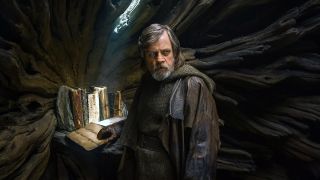
The Jedi and their precursors, the Dai Bendu, came to exist way before the Sith cult, which was later created by an unnamed rogue Jedi who then declared war on their former comrades. In the far distant past, roughly 25,000 years BBY (Before the Battle of Yavin), the Prime Jedi founded the Jedi Order on the planet of Ahch-To. Legend suggests that the first-ever Jedi and other Force users used Force-imbued swords before lightsabers were invented.
However, it wasn't long before the first Jedi found the ice planet of Ilum, which was littered with kyber crystals , the 'heart' of all lightsabers. It soon became the Order's most sacred world and the base of operations for Professor Huyang, a droid who, for over a thousand years, instructed apprentices on lightsaber designs. Around the same time, the Order also spread to worlds such as Ossus, Jedha, Xenxiar, Tython, and even Coruscant.
The 'sacred texts' of the Jedi described the Order's tenets and history, as well as providing an introduction to the path of the Jedi across several volumes. That said, some elements found within those pages had little to no impact on later Jedi; those included references to 'gods' and the World Between Worlds that we later see Ahsoka Tano enter.
Around the year 20,000 BBY, a Jedi sect known as the Ordu Aspectu broke off from the main Order. Led by Rur and his second in command, Amon, their main goal was learning the secret to immortality. Unsurprisingly, this led to an open conflict between the Jedi Order and the Ordu Aspectu, though a peace treaty allowed them to continue their research. A later incident with a rogue artificial intelligence led to the self-destruction of the Ordu Aspectu, ending the cult forever.
The Jedi Order during Old Republic times
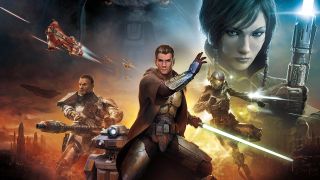
The Sith Order, which shares its name with a red-skinned alien species connected in special ways to the dark side of the Force, was firmly formed around 5,000 BBY by the aforementioned rogue Jedi. The early Sith wanted to explore the mysteries of the dark side of the Force, but also rejected many of the Jedi Order's key teachings.
The first open war between the two Orders ended with the Sith defeated, retreating to and colonizing the red world of Korriban, later known as Moraband. In the shadows, they rebuilt over generations and formed an Empire that would later strike against the Old Republic and their Jedi protectors.
Around this time, the Order also set up a new headquarters on Coruscant, a planet located roughly at the center of the known galaxy. Their temple on the planet would become the Order's main hub for thousands of generations. Unbeknownst to them, however, the ancient Sith shrine buried below it, thought to be 'neutralized' long ago, emanated dark side power that 'infiltrated' the space above and weakened the Jedi for millennia. Check out our article on the history of the Sith Order for more information on the Jedi's dark mirror.
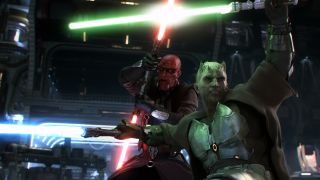
During the Old Republic era, the Jedi Order also came into conflict against factions that threatened the Republic's ideals of peace and freedom. Their biggest enemies included the Zygerrian Slave Empire and the Mandalorians , who'd developed a warlike culture that threatened to devour the galaxy if left unchecked.
Later wars against the Sith Empire, who even managed to conquer Coruscant for a time, pushed the Jedi to adopt more aggressive lightsaber combat forms. While this was extremely effective, it also led many Jedi to the dark side. As a direct result, the Order was quick to ban their use after the fires of war were extinguished.
Towards the end of the Dark Age (defined by the seemingly endless battles against the Sith), the Old Republic's system faced an imminent collapse. Despite this the Jedi were able to defeat the Sith Empire after the latter was irreparably weakened by ill-timed infighting. After the Sith's definitive defeat on the planet Ruusan, only Darth Bane remained. The Sith Order's survival in the shadows under Darth Bane’s Rule of Two ("One master and one apprentice can be the only Sith in the galaxy at a time") would eventually lead to the Jedi's undoing.
The High Republic and the golden age of the Jedi

The modern Galactic Republic replaced the Old Republic around the year 1,000 BBY. This heralded a new era of peace, democracy, and prosperity under the steady rule of the Galactic Senate and its elected leader, the Supreme Chancellor. At this point, the Jedi fully embraced their role as the Republic's peacekeepers and guardians. The Galactic republic was at the height of its power from around 500 BBY to 100 BBY – a period known as the High Republic era.
The Jedi of this era were neither soldiers nor monk-like figures, instead serving as law enforcement agents that pursued dangerous criminals and often acted as detectives. The Jedi Order did eventually lose its firm grip on the galaxy's evildoers and rejected the idea of the Sith returning until it was too late. However, until then the High Republic was a period of relative peace and a lack of major galaxy-wide warfare.
Regardless, the Jedi were still involved in a number of notable conflicts, like the ones against the Path of the Open Hand cult – who wanted to 'free' the Force – or the Nihil marauders, and suffered heavy losses during certain battles and events that weakened the grand Order's position as the galaxy's first line of defense. This led to an internal debate within the Jedi Order that made some members question how involved with the Republic they should be.
The Fall of the Jedi and the Clones Wars

Prior to the Invasion of Naboo in the year 32 BBY, the Jedi Master Sifo-Dyas sought to create a Grand Army of the Republic after predicting a galactic conflict that would end the government as well as the Jedi Order. This led to his removal from the Council and him secretly commissioning an army of clone soldiers from the inhabitants of Kamino.
Unbeknownst to the Jedi Master, the Sith, who'd continued to plot and design the Jedi's downfall in the shadows for centuries and were now led by Darth Sidious, learned about his plan and had him killed by the Pyke Syndicate. Following the Battle of Naboo and the election of Sheev Palpatine – Sidious' public persona – as Chancellor, Count Dooku replaced Darth Maul as the Sith Lord's apprentice and became Darth Tyranus.
The Jedi wouldn't find out about the existence of a clone army until the Separatist Crisis (orchestrated by Darth Sidious) became a threat to the Republic's stability. It was the Jedi Master Obi-Wan Kenobi who learned about the clone army, although he only got half of the truth from the Kaminoans, as they'd also been tricked – the clone army were now designed by the Sith and 'rigged' to turn on the Jedi when the time came.
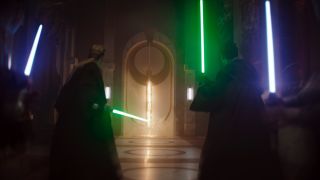
Concerned by the growing number of Separatist systems, the Senate, now steered by the Chancellor's evil designs, approved the Military Creation Act and deployed the clone army on Geonosis alongside a Jedi assault team led by Master Yoda and Mace Windu. The First Battle of Geonosis – launched against the Separatist leaders, Count Dooku/Tyranus, and their droid army – marked the beginning of the three-year-long Clone Wars, which broke the galaxy apart.
Out of necessity, the Jedi became generals and commanders once again, now leading a clone army against the Separatists, a coalition made up from worlds that had once been part of the Republic along with some supporting Outer Rim systems. Of course, many Jedi questioned their involvement in the war and its very nature, yet Sidious, Count Dooku/Darth Tyranus, and their allies managed to keep the 'show' going long enough to finalize their plans to take over the government and end the Jedi once and for all.
The Clone Wars ended in the year 19 BBY, when Count Dooku/Darth Tyranus was felled by Anakin Skywalker and General Grievous was destroyed by his Master, Obi-Wan Kenobi. This was all part of Darth Sidious' Grand Plan and led to the final phase: the activation of Order 66. This infamous directive saw the clone troopers turning on their Jedi leaders, and the creation of the Galactic Empire to 'reorganize' and ensure the security of the galaxy after a time of war and division.
The dark times and the Return of the Jedi

While some Jedi survivors escaped the purge and remained hidden away in remote worlds, Order 66 was largely a success and effectively destroyed the Jedi Order and most of its following. This paved the way for the Empire's unchecked expansion across the galaxy.
During the Reign of the Empire, Darth Sidious ruled as Emperor Palpatine with the help of Darth Vader, formerly Anakin Skywalker (the Chosen One according to some of the Jedi), as his right-hand man. Some Jedi who'd been captured were also twisted by the dark side and turned into Inquisitors who helped track down and kill the remaining Jedi until they were no longer useful to Palpatine and Vader.
Some persistent Jedi rebels survived, including Ahsoka Tano (Skywalker's former Padawan), Cal Kestis, and Kanan Jarrus, but they were scattered and alone, unable to bring down the Empire. Sidious' empire would ultimately fall at the hands of Luke Skywalker, Anakin Skywalker's secret son. Luke Skywalker was trained in the Jedi ways by Obi-Wan Kenobi, Anakin's old master, and joined the Rebel Alliance alongside his sister, Leia Organa.
Both Darth Sidious and Darth Vader tried to seduce Luke Skywalker into joining the Sith during the Battle of Endor, in the year 4 ABY (After the Battle of Yavin). Once again, infighting would be the downfall of the Sith Order, as each of them had their own plans to kill and replace the other. In the end, the young Jedi Luke Skywalker brought Darth Vader back into the light and reached Anakin. Before dying from grave injuries, Anakin saved his son Luke and ended Sidious' life aboard the second Death Star. The battle station was also destroyed by the Rebels, putting the Empire on the defensive.
New Republic era and the Last Jedi
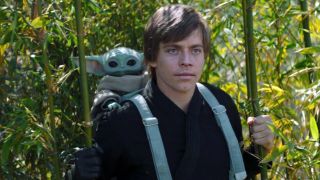
Following the deaths of both Emperor Palpatine and Darth Vader, Imperial loyalists put up a fight against the Alliance that soon formed the New Republic, but ultimately failed to preserve the late Galactic Empire. Meanwhile, Luke Skywalker began to train his sister Leia as a Jedi. She went as far as constructing her own lightsaber, but declined further training after seeing a vision of her son's death, and instead chose to focus on building the New Republic.
At the same time, Ahsoka Tano commenced the training of the Mandalorian warrior and Rebel fighter Sabine Wren while searching for Ezra Bridger , a Jedi Padawan apprentice of Kanan Jarrus who had removed himself from the galaxy alongside Grand Admiral Thrawn . Bridger was found and returned to the galaxy alongside Thrawn and his new allies, while Tano and Wren were left behind. This specific tale has yet to be fully told, but Thrawn's attempt to restore the Empire likely led to the creation of the First Order.
Knowing his training was unorthodox, Luke aimed to give his New Jedi Order students a training regime similar to the one used during the Republic days. His Jedi temple and students on Ossus thrived. That was until around 28 ABY, when Ben Solo, son of Leia and Han Solo, was seduced to the dark side by Supreme Leader Snoke. Ben’s descent into darkness culminated with the destruction of the Jedi Temple and the slaughter of the Jedi training there after Luke confronted him. This failure set Skywalker on a path of shame and regret.
Ben Solo rose to lead the dark side fanatics known as the Knights of Ren, forging an alliance with Snoke, who'd been pulling the strings of the First Order. This new order was a fascist organization that rose from the ashes of the Empire after amassing power deep within the Unknown Regions of space. Ben took on the new moniker of Kylo Ren at this time. Meanwhile, Luke turned his back on the galaxy and exiled himself in the first Jedi temple on Ahch-To, leaving only a cryptic star map behind to give away his whereabouts.

The First Order launched an attack on the New Republic and effectively neutralized its military power. At the same time, a scavenger from Jakku, called Rey, came across the lightsaber that Luke lost on Bespin after fighting Darth Vader, and ended up joining the Resistance. Leia later sent the Force-sensitive girl to find Luke on Ahch-To after the star map was completed. There, she started to pull the old Jedi Master out of his pit of despair, and eventually underwent Jedi training.
Rey's training and temporary alliance with a conflicted Kylo Ren led to the death of Snoke, yet the Resistance almost perished on Crait when Ren assaulted the base. Only the timely intervention of Luke Skywalker saved the day, when he used all the energy he had to Force-project himself across the galaxy from Ahch-To and confront his nephew. This bought Rey and the Resistance enough time to escape and resulted in Luke passing away and becoming a Force Ghost, as well as a symbol of resistance and hope in the galaxy.
Roughly a year after the Battle of Crait, it was revealed that a secret Sith cult known as the Sith Eternal had managed to clone Darth Sidious' body on the ancient Sith planet of Exegol, transferring his lingering spirit into it. This shadowy group was also revealed to be behind Snoke's creation. The Sith fleet absorbed what remained of the unsuspecting First Order and launched an all-out attack against the galaxy to try to establish a new Sith Empire.
Rey, after learning she was the lost 'granddaughter' of the phantom Emperor, confronted Sidious and destroyed him with the help of the Jedi who came before her. At the same time, a civilian uprising across the galaxy countered the Sith Eternal's offensive. Ben Solo, brought back to the light by Rey, was key to defeating Sidious and ended up sacrificing himself to save Rey from certain death.
After burying Luke and Leia's lightsabers on Tatooine, the desert homeworld of the Skywalkers, Rey adopted their surname and set out to finally restore the Jedi Order without the shadows of the Sith looming over her.
Join our Space Forums to keep talking space on the latest missions, night sky and more! And if you have a news tip, correction or comment, let us know at: [email protected].
Get the Space.com Newsletter
Breaking space news, the latest updates on rocket launches, skywatching events and more!

Fran Ruiz is our resident Star Wars guy. His hunger for movies and TV series is only matched by his love for video games. He got a BA of English Studies, focusing on English Literature, from the University of Malaga, in Spain, as well as a Master's Degree in English Studies, Multilingual and Intercultural Communication. On top of writing features and other longform articles for Space.com since 2021, he is a frequent collaborator of VG247 and other gaming sites. He also serves as associate editor over at Star Wars News Net and its sister site, Movie News Net.
Star Wars Day 2024: 'Star Wars: Tales of the Empire' premieres today on Disney+
This Week In Space podcast: Episode 109 — Music of the Spheres
Euclid telescope: A scientist tells us of his quest to understand the nature of dark matter and dark energy
Most Popular
- 2 Boeing's Starliner to join exclusive spacecraft club with 1st astronaut launch today
- 3 'Lost' satellite found after orbiting undetected for 25 years
- 4 Boeing's Starliner is a 'big piece of America's overall strategy for access to low Earth orbit,' astronaut says
- 5 Handle Mars with care: Guidelines needed for responsible Red Planet exploration, experts say
‘May the fourth be with you:' How the 4th day in May came to be a ‘Star Wars' holiday
The first use of the "may the fourth be with you" phrase came from the most unlikely source., by maria chamberlain • published may 3, 2024 • updated on may 3, 2024 at 5:27 pm.
All across the galaxy, jedis and siths are celebrating "Star Wars" Day .
Here's what it is, how the unofficial holiday came to be, and what to say if someone says, "May the fourth be with you."
Why is 'Star Wars' Day celebrated?
In the 1977 film, "Star Wars: A New Hope," the phrase "May the force be with you" is said by Jedi Master Obi-Wan Kenobi to Luke Skywalker and is again mentioned throughout the movie franchise.
Get Tri-state area news and weather forecasts to your inbox. Sign up for NBC New York newsletters.
The unofficial holiday grew organically as a way for fans to celebrate the "Star Wars" movieverse as May the 4th sounds a lot like "May the force."
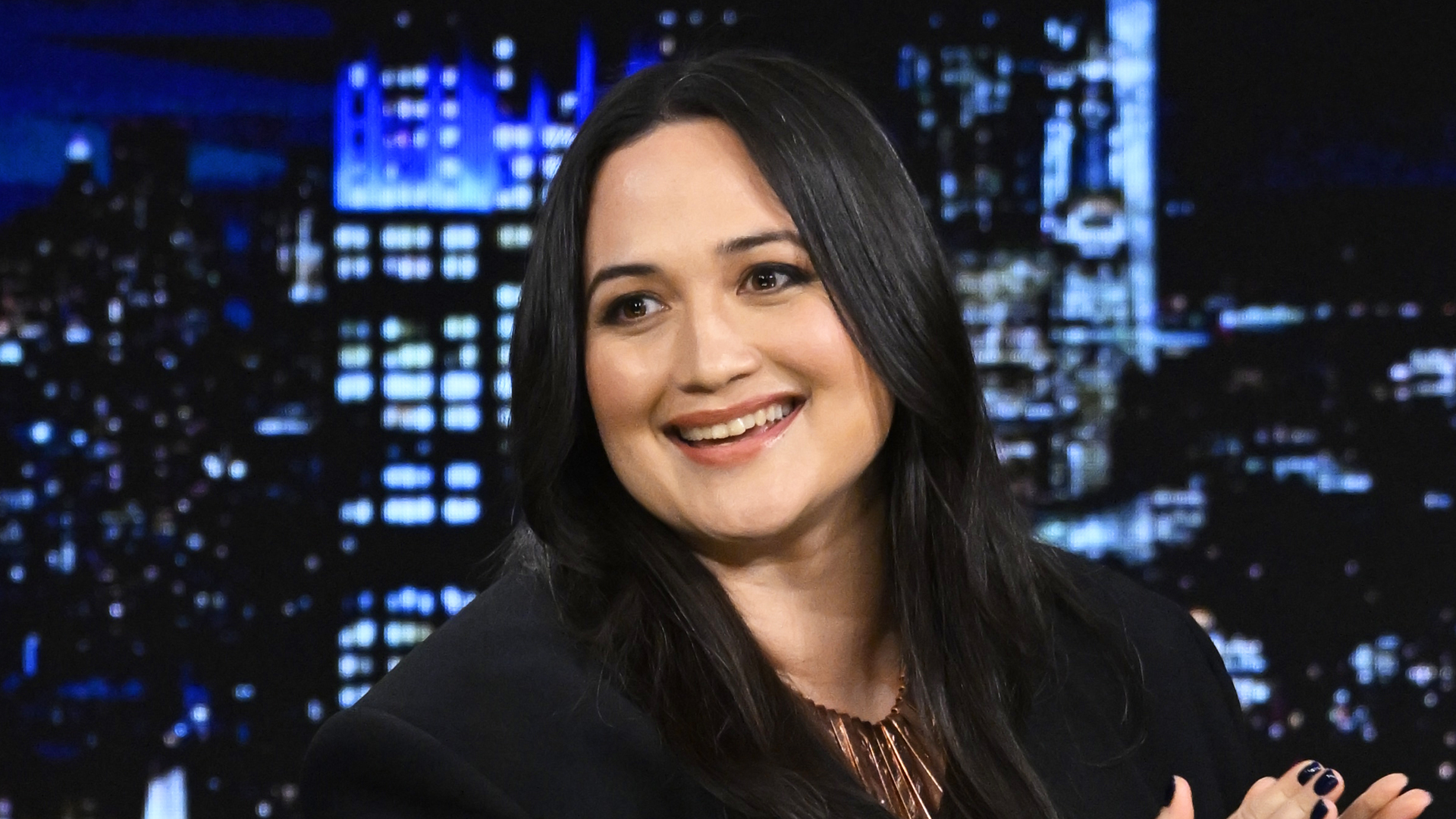
Lily Gladstone and Harrison Ford bonded over ‘Star Wars' at the Golden Globes

Jodie Foster says she almost played Princess Leia in ‘Star Wars.' Here's why she turned it down
When did 'star wars' day start.
According to StarWars.com , the first use of the phrase came from the most unlikely source -- a British political ad.
British prime minister Margaret Thatcher was elected to office on May 4, 1979, two years after "Star Wars" was released. To congratulate her, the Conservative Party placed an ad in the London Evening News. It read, "May The Fourth Be With You, Maggie. Congratulations.”

Thanks to the power of the internet and fans all over the world, the phrase has become what it is today.
How to respond to 'May the 4th be with you'
The correct response differs depending on who you ask. Perhaps fans were inspired by the Catholic faith as one popular response echoes that of the church.
"And also with you" or "and with your spirit" (in line with the updated response during Mass).
Other responses include "May the 4th be with us all" or "May the 4th be with us both."
How you can celebrate
Have a "Star Wars" movie marathon or head to Disney+ to binge "Star Wars: The Bad Batch" following the recent series finale.
She's ready. The series finale of Star Wars: #TheBadBatch is now available on @DisneyPlus . https://t.co/MXWYWOBIgD pic.twitter.com/4tTUSvR12v — Star Wars: The Bad Batch (@TheBadBatch) May 3, 2024
Editor's Note: This story was first published in 2023.
This article tagged under:
Why is 'Star Wars' Day on May 4? What is it? Here's how the unofficial holiday came to be
'may the force be with you,' or 'may the 4th be with you' saturday is "star wars" day, the unofficial celebration of the beloved space opera that falls every year on may 4..

Once simply a campy sci-fi series of the 1970s and 80s, "Star Wars" has grown into an omnipresent pop culture behemoth with its own theme park and a never-ending stream of movies, television series and merchandise.
But if you still can't quite get enough of the galaxy far, far away, the iconic franchise has its own holiday, too – even if it's one entirely made up.
Saturday is "Star Wars" Day , the unofficial celebration of the beloved space opera that falls every year on May 4. That means plenty of "Star Wars" festivals in cities across the nation , special deals from retailers looking to capitalize on the hype and – fingers crossed! – perhaps an announcement or two from Disney about the future of the franchise.
Here's everything to know about "Star Wars" Day.
'Star Wars' Day: Celebrate May the 4th with these deals
Why is May 4 'Star Wars' Day?
It's no accident that "Star Wars" Day is celebrated on May 4.
Anyone who is a fan of the series knows well that Obi-Wan Kenobi and other Jedi often use the phrase, "May the force be with you," as a sentiment of good will. Well, as fans have come to realize, the phrase can sound a lot like "May the 4th be with you" – and a holiday was born.
So, yes, the date on which "Star Wars" Day is celebrated every year is based solely off of a pun.
When did 'Star Wars' Day start?
Because it originated as a fan holiday, "Star Wars" Day has no official origin or even commencement year.
The earliest uses of the phrase “May the 4th Be With You” dates to 1978, one year after the release of " Star Wars: Episode IV – A New Hope ," according to StarWars.com . It didn't take long for the vernacular of the film to become ingrained in American popular culture, as “May the force be with you,” had been appearing on buttons, posters and other items for months after the film's release.
By that summer, newspaper writers used the phrase as a gimmick to mark Independence Day celebrations on July 4, according to StarWars.com.
Another one of the earliest uses of the phrase came on May 4, 1979, when a London newspaper writer congratulated Britain’s new prime minister, Margaret Thatcher, on her first day of office, StarWars.com says. In a full-page ad the writer said, “May the Fourth Be With You, Maggie. Congratulations!”
The phrase resurfaced once again in July 2005, weeks after the release of " Star Wars: Episode III – Revenge of the Sith ." A marketing push to bring audiences back to theaters inspired a newspaper ad with Yoda in front of a patriotic background of red-white-and-blue fireworks with the phrase, “May the Fourth Be With You,” at the top.
But the concept didn't really start taking off until the advent of social media as users began using it in hashtags. Though it began as a way for fans to host themed parties or revisit the films, retailers were quick to take advantage of the trend with marketing pushes of their own.
Where to watch 'Star Wars' shows, movies
Because May 4 falls on a weekend this year, it may be the perfect time to kick back and host a "Star Wars" marathon.
All 11 of the live action films – the three trilogies and two standalones, " Rogue One " (2016) and " S olo " (2018) – are available to stream on Disney+ .
Starting May 4, "Star Wars" fans will also be able to watch all nine films that comprise the "Skywalker Saga" in select theaters nationwide to celebrate the 25th anniversary of " Star Wars: Episode I – The Phantom Menace ."
Disney, which acquired Lucasfilm in 2012, has tirelessly churned out plenty of "Star Wars" content in the ensuing years, including both live-action and animated series that are also available on its streaming platform.
Just in time for "Star Wars" Day, the latest series, the " Tales of the Empire ," will hit Disney+ on Saturday. The animated series created by Dave Filoni follows two characters in different time periods as they fight the evil Galactic Empire.
Check out the trailer here:
Monthly subscription rates for Disney+ start at $9.99.
Eric Lagatta covers breaking and trending news for USA TODAY. Reach him at [email protected]
Screen Rant
Star trek: ds9 predicted the klingon-cardassian war 2 years earlier.

Your changes have been saved
Email Is sent
Please verify your email address.
You’ve reached your account maximum for followed topics.
I Didn’t Know Where Roddenberry Got The Name Klingon In Star Trek Until Now
Star trek: ds9's armin shimerman hated portraying quark as "ugly", after 31 years, star trek confirms a deep space 9 in-joke in the most hilarious way.
- Deep Space Nine accurately predicted the Klingon-Cardassian War two years before it occurred in season 4, destabilizing the Federation's relationships.
- The addition of Worf to the DS9 cast in season 4 marked a reboot for the show, improving public perception significantly.
- The conflict between Cardassians and Klingons in Garak's novel led to devastating losses for Cardassians, eroding their culture and autonomy.
Star Trek: Deep Space Nine predicted a war between the Cardassians and Klingons two years before the conflict broke out in DS9 season 4. The Klingon-Cardassian War was a flashpoint in the conflict between the Federation, their allies, and the Dominion. Instigated by a Changeling infiltrator within the Klingon Empire, the war between the Klingons and Cardassians raged between 2372 and 2373 . The bloody conflict was a successful attempt to destabilize the Federation's relationships with its allies, and was a key moment in the lead up to DS9 's Dominion War .
The conflict with the Klingons was so severe that it inspired Captain Benjamin Sisko (Avery Brooks) to have Lt. Commander Worf (Michael Dorn) assigned to DS9 full time as both an advisor and tactical officer. The Klingon-Cardassian War, and the addition of Worf to the cast of Star Trek: Deep Space Nine in season 4 was a soft reboot for the show, that led to a significant improvement in public perception of DS9 . However, a throwaway line in Star Trek: Deep Space Nine season 2, episode 22, "The Wire", predicted the whole conflict, even before DS9 's writers conceived of the Klingon-Cardassian War .
The Klingons are one of the most famous alien races from Star Trek, but Gene Roddenberry derived the name from his real life as a police officer.
DS9 Predicted Star Trek’s Klingon-Cardassian War 2 Years Earlier
"who wins" "who do you think".
Star Trek: Deep Space Nine season 2, episode 22, "The Wire" centers on the friendship between Dr. Julian Bashir (Alexander Siddig) and Elim Garak (Andrew Robinson) as DS9's chief medical officer fights to save the Cardassian tailor's life. With Garak's condition stabilized by the end of the episode, Garak and Bashir resume their weekly lunch dates, where they discuss the merits of Federation and Cardassian literature. Garak lends Bashir a novel set in a potential future where the Cardassian Union is at war with the Klingon Empire . When asked by Bashir who wins the war, Garak wryly replies " Who do you think? "
"The Wire" is a pivotal episode for Garak and the Cardassians, as it introduces the Obsidian Order, and officially names the Cardassians' home planet as Cardassia Prime.
The Cardassian-Klingon war in Garak's novel was not intended as ominous foreshadowing by writer Robert Hewitt Wolfe. Instead, it was a joke about how Garak saw his taste in literature as more refined than Bashir's, despite it being jingoistic propaganda about the Cardassians' superiority over the Klingon Empire. It was only later, when Rick Berman suggested adding Worf to the cast of Star Trek: Deep Space Nine , that the idea of a conflict between the Klingons and Cardassians was devised as a way to justify bringing Michael Dorn's beloved Star Trek: The Next Generation character aboard .
Garak Was Wrong, The Cardassians Lost The Klingon War
"please, doctor. spare me your insufferable federation optimism. of course it will survive, but as not the cardassia i knew.".
The war between the Klingon Empire and the Cardassian Union effectively came to an end when Gul Dukat (Marc Alaimo) negotiated for the Cardassians to join the Dominion. In the short term, this meant that the Cardassians were able to repel the Klingon forces with the help of the Jem'Hadar in Star Trek: Deep Space Nine season 5, episode 15, "By Inferno's Light". In the long term, it led to a longer conflict that ultimately decimated Cardassia Prime. The alliance with the Dominion cost the Cardassians dearly, as their autonomy was eroded by the tyrany of the Female Changeling (Salome Jens) and Weyoun (Jeffrey Combs).
Garak and Major Kira Nerys (Nana Visitor) aided the Cardassian military in rising up against the Dominion in Star Trek: Deep Space Nine 's finale, but their former allies unleashed devastating reprisals against Cardassia Prime. Eight hundred million Cardassians died, a combination of the losses incurred during the Battle of Cardassia, and those incurred by the Dominion's violent reprisals. Gul Dukat may have secured the Cardassians a momentary victory in the war against the Klingons, but he signed the death warrant for eight hundred million of his fellow Cardassians and erased much of the culture, art, music, and literature that was so beloved by Garak.
All episodes of Star Trek: Deep Space Nine are streaming now on Paramount+.
Star Trek: Deep Space Nine
*Availability in US
Not available
Star Trek: Deep Space Nine, also known as DS9, is the fourth series in the long-running Sci-Fi franchise, Star Trek. DS9 was created by Rick Berman and Michael Piller, and stars Avery Brooks, René Auberjonois, Terry Farrell, and Cirroc Lofton. This particular series follows a group of individuals in a space station near a planet called Bajor.
- Star Trek: Deep Space Nine (1993)

What is the first ‘Star Wars’ movie? When did it come out? Release date in the US
The Star Wars franchise is undoubtedly one of the most successful science fiction movie series in cinema history . Since the first film was released in the 1970s, it has gained immense popularity and amassed a massive and loyal fan base over the decades .
What was the first Star Wars movie, and when did it come out?
The first movie, Star Wars Episode IV: A New Hope, was released in the US on May 25, 1977 . It featured relatively unknown actors who soon became iconic and an integral part of a global cultural phenomenon .
The film was a technological and visual marvel for its CGI-less time. It featured groundbreaking special effects and a unique visual style that had never been seen before. The stunning effects of Star Wars , achieved with the painstaking use of models and miniatures (and one of the most famous puppets too!), helped create a vivid world that captivated the imagination of many.
Why did Star Wars become so popular?
Star Wars’ success can be attributed partly to its classic storyline —the battle between good and evil. The audience related to and rooted for its memorable characters, and Darth Vader, aided by his personal music theme, achieved a level of villainy that few have matched.
The marketing and merchandising campaigns to promote it were also innovative, and helped make Star Wars a household name. The characters, easy to recognize and make action figures of, spawned sales of a variety of merchandise, including toys, clothing, and an infinite number of Lego sets .
Since Episode IV ’s premiere, the movie series has become a monumental franchise that includes several sequels, prequels, spin-offs, and television series , all telling stories of various parts, characters, and timelines of the Star Wars universe .


IMAGES
VIDEO
COMMENTS
While "Star Wars: Episode IV - A New Hope," opened on May 25, 1977, "Star Trek: The Original Series" premiered on NBC over a decade prior, with its first episode, "The Man Trap," airing on ...
A fan of Star Trek dressed in Starfleet uniform (left) and a fan of Star Wars dressed in Imperial Death Star gunner uniform (right) at a fan convention. Star Trek and Star Wars are American media franchises which present alternative scenarios of space adventure. The two franchises proliferate in this setting of storytelling, and each has offered various forms of media productions for decades.
Star Trek, originally a TV series, is a space western science fiction that centers around a crew who serves in Starfleet, a space-based peacekeeping and humanitarian armada.Star Wars, originally a trilogy, is a space opera fantasy franchise set in the distant past of a fictional galaxy, revolving around princes, princesses, knighthood, and chivalry.
8 In Star Trek, Technobabble Saves The Day. Star Trek emphasizes the science in "science fiction" way more than Star Wars. Even the original series, which was more known for philosophy, used a lot of technobabble, something later shows and movies would lean into. Star Trek shows even brought on science advisors to give the show's science some ...
Star Trek is an aspirational sci-fi series set in humanity's future, while Star Wars is a bombastic fantasy adventure that takes place in a far-off galaxy. One has primarily lived on weekly ...
Star Trek began with a larger corpus of content, 79 episodes on TV and in syndication compared to Star Wars' original three-movie episodes spanned across almost a decade. Arc vs. Episodic Star Wars' story was an epic arc as multi-hour major movie events across three episodes, while Star Trek had 79 one-hour episodes across three years.
9 Star Trek: Utopia. While Star Wars is focused on having faith in an external source (although the Force is also an internal source. It really is hard to explain), Star Trek is about faith in humanity. Gene Roddenberry's vision of the future is one where Earth is a utopia.
Star Trek is an American science fiction media franchise created by Gene Roddenberry, which began with the eponymous 1960s television series and became a worldwide pop-culture phenomenon.Since its creation, the franchise has expanded into various films, television series, video games, novels, and comic books, and it has become one of the most recognizable and highest-grossing media franchises ...
Star Wars is a science fantasy/fiction multi-media franchise created by George Lucas. From its very inception in the form of the first 1977 Star Wars film installment, there has been a definite rivalry between the Star Wars and Star Trek franchises, which Rod Roddenberry - son of Star Trek creator Gene Roddenberry - learned of through first-hand experience, though he was a much bigger fan ...
Some people love Star Wars and Star Trek so much that they spend their lives attending conventions, hunting down rare collectibles, and even naming their children after the characters. Though the ...
This article discusses the fictional timeline of the Star Trek franchise.The franchise is primarily set in the future, ranging from the mid-22nd century (Star Trek: Enterprise) to the late 24th century (Star Trek: Picard), with the third season of Star Trek: Discovery jumping forward to the 32nd century.However the franchise has also outlined a fictional future history of Earth prior to this ...
Stashwick of Team Wars: Stashwick noted that with J.J. Abrams, he "clearly was a Star Wars man" who was "handed the keys to the Star Trek kingdom and he made a Star Wars version of Star Trek," but Stashwick then noted that with Star Wars, "just because you blew up a Death Star once, your problems aren't over."Beating back the demons is "an eternal struggle" and "a noble pursuit."
SpaceNews Senior Staff Writer Jeff Foust, third from left, moderates the Star Trek vs. Star Wars debate Thursday at Redwire's booth during the 39th Space Symposium in Colorado Springs.
Star Trek: Which Came First (And Why Does It Matter)? - Looper. Home. News. Star Wars Vs. Star Trek: Which Came First (And Why Does It Matter)? - Looper. By: November 6, 2023. The two most impactful science fiction franchises of the 20th century, "Star Wars" and "Star Trek," have inspired generations of fans while …Google Alert ...
Join the debate on Star Trek vs Star Wars. We break down the differences, similarities, and fan-favorite elements of each iconic universe. Star Trek is about deep space exploration with the Enterprise, while Star Wars is about epic battles between good guys and bad guys. ... There was only one cartoon series in the mid-70s until the first Star ...
Star Trek and Star Wars are naturally compared by fans despite being entirely different sci-fi animals. Both have longevity, but Star Wars is at a place in its growth as a franchise akin to The Next Generation for Star Trek. The biggest difference is how fandom influenced the first Star Trek and Star Wars projects made without their creators.
The following is a list of all military conflicts, rebellions, coups, etc. that have occurred from the distant past to the far future, organized by date. Slaver war: one billion years ago (TAS: "The Slaver Weapon") Arretan final war: 500,000 years ago (TOS: "Return to Tomorrow") Orbital bombardment of Iconia: 200,000 years ago (TNG: "Contagion"; DS9: "To the Death") Unspecified Mesopotamian ...
One of Star Trek's earliest wars was the Eugenics Wars, which took place from 1992-1996 in canon. The Eugenics Wars were never shown directly on-screen but were referenced heavily in episodes of TOS and Star Trek: Enterprise.They began when a group of scientists sought to use genetic engineering to improve humanity, creating a race of superhumans who had superior strength, stamina, and intellect.
Sci-fi. Star Trek. The Breen were a reclusive, powerful, and warlike humanoid race native to the planet Breen in the Alpha Quadrant. Shrouded in mystery, the Breen were also one of the most underestimated races inhabiting that quadrant of space. Historically, the Klingons were among the first to discover that the...
Etymology []. The USS Discovery at warp in 2257. The USS Stargazer performs a warp jump. In 2063, the term "warp drive" was already used by Zefram Cochrane of his engine on the Phoenix.However, Cochrane used the term "space warp generator" in the monitor displays on his spacecraft. (Star Trek: First Contact) Even as late as the 2150s, the warp five engine was still officially known as a ...
Star Trek: Created by Gene Roddenberry. With Leonard Nimoy, William Shatner, DeForest Kelley, Nichelle Nichols. In the 23rd Century, Captain James T. Kirk and the crew of the U.S.S. Enterprise explore the galaxy and defend the United Federation of Planets.
In fact, in their decades-long history, Star Wars and Star Trek haven't actually directly clashed all that often (although the early '80s of The Empire Strikes Back followed by Wrath of Khan ...
In the far distant past, roughly 25,000 years BBY (Before the Battle of Yavin), the Prime Jedi founded the Jedi Order on the planet of Ahch-To. Legend suggests that the first-ever Jedi and other ...
In the 1977 film, "Star Wars: A New Hope," the phrase "May the force be with you" is said by Jedi Master Obi-Wan Kenobi to Luke Skywalker and is again mentioned throughout the movie franchise. The ...
Because it originated as a fan holiday, "Star Wars" Day has no official origin or even commencement year. The earliest uses of the phrase "May the 4th Be With You" dates to 1978, one year ...
Logo for the first Star Trek film, Star Trek: The Motion Picture (1979). Star Trek is an American science fiction media franchise that started with a television series (simply called Star Trek but now referred to as Star Trek: The Original Series) created by Gene Roddenberry.The series was first broadcast from 1966 to 1969. Since then, the Star Trek canon has expanded to include many other ...
Star Trek: Deep Space Nine predicted a war between the Cardassians and Klingons two years before the conflict broke out in DS9 season 4.The Klingon-Cardassian War was a flashpoint in the conflict between the Federation, their allies, and the Dominion. Instigated by a Changeling infiltrator within the Klingon Empire, the war between the Klingons and Cardassians raged between 2372 and 2373.
The Star Wars franchise is undoubtedly one of the most successful science fiction movie series in cinema history.Since the first film was released in the 1970s, it has gained immense popularity ...
The latest Star Wars series centers on Jedi Ahsoka Tano, with Dawson starring in the first female-led Star Wars TV series. Ahsoka provides a glimpse at the early formation of the First Order.